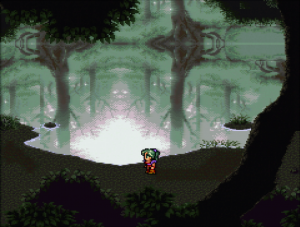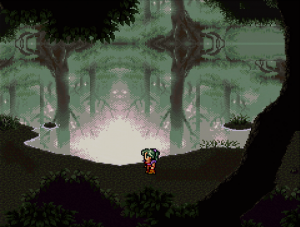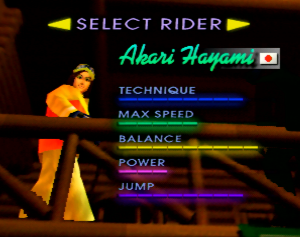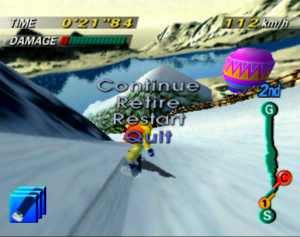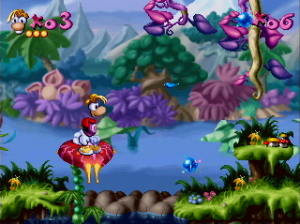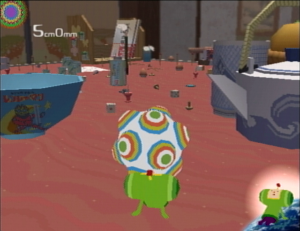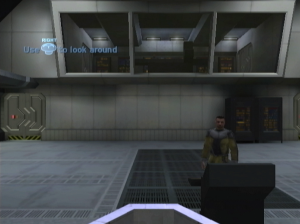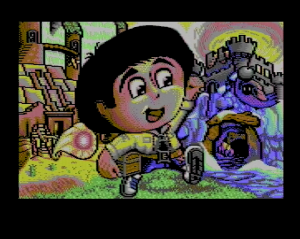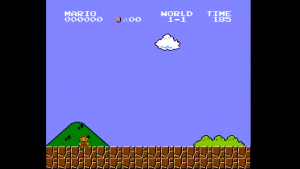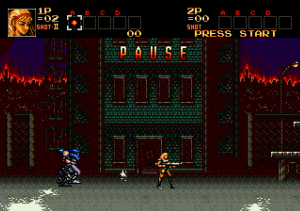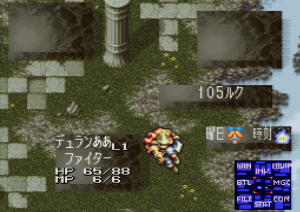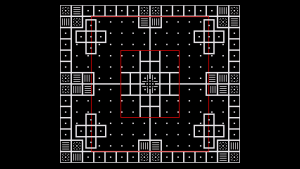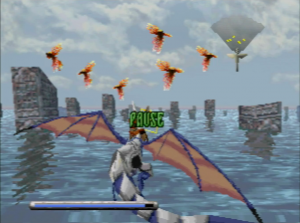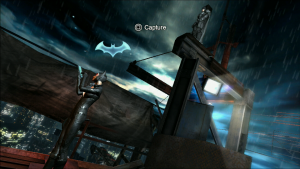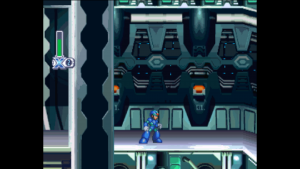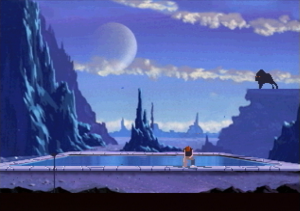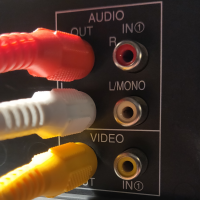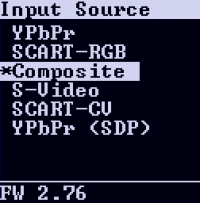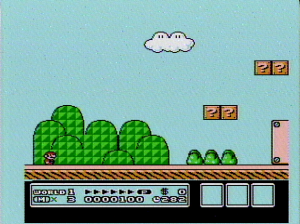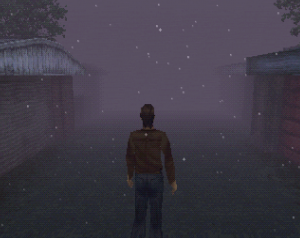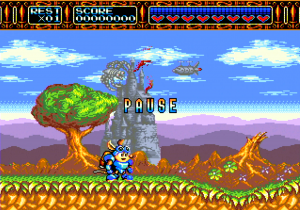AV:RetroTINK-5X Pro/pt: Difference between revisions
No edit summary |
(Created page with "==== Sinais progressivos==== Diferentemente de vídeo entrelaçado, modos de vídeo progressivo são exibidos na tela em um passo, e assim não precisam ser desentrelaçados para serem exibidos em painéis modernos. Modos progressivos comuns em consoles retrô incluem 240p, 480p e 720p. Por não requererem processamento adicional, são tipicamente encontrados em sinais de qualidade mais alta (usualmente descritos como mais afiado ou limpo) e na maioria dos casos preferí...") |
||
| Line 854: | Line 854: | ||
Enquanto entrelaçado o vídeo é ainda utilizado em certas situações, painéis modernos não processam vídeo da mesma forma, e vídeo entrelaçado precisa ser convertido para imagem ''progressiva'' antes de ser exibida. O processo de tornar um sinal de vídeo entrelaçado em progressivo é conhecido como ''desentrelaçamento''. Enquanto '''''desentrelaçamento adaptativo de movimento''''' é o mais sofisticado e é o desentrelaçador padrão no RetroTINK-5X Pro, existem situações nas quais outros métodos de desentrelaçamento podem criar efeitos desejáveis, como '''Bob''' e modos de linhas de varreduras Bob correspondentes [[AV:RetroTINK-5X_Pro#Modo_de_linhas_de_varredura_Bobo|Modos de linhas de varredura Bob]]. Mais sobre as opções e exemplos de desentrelaçamento do RetroTINK-5X Pro estão destacados na seção de [[AV:RetroTINK-5X_Pro#Interpolação/Desentrelaçamento|Interpolação/Desentrelaçamento]] do documento. | Enquanto entrelaçado o vídeo é ainda utilizado em certas situações, painéis modernos não processam vídeo da mesma forma, e vídeo entrelaçado precisa ser convertido para imagem ''progressiva'' antes de ser exibida. O processo de tornar um sinal de vídeo entrelaçado em progressivo é conhecido como ''desentrelaçamento''. Enquanto '''''desentrelaçamento adaptativo de movimento''''' é o mais sofisticado e é o desentrelaçador padrão no RetroTINK-5X Pro, existem situações nas quais outros métodos de desentrelaçamento podem criar efeitos desejáveis, como '''Bob''' e modos de linhas de varreduras Bob correspondentes [[AV:RetroTINK-5X_Pro#Modo_de_linhas_de_varredura_Bobo|Modos de linhas de varredura Bob]]. Mais sobre as opções e exemplos de desentrelaçamento do RetroTINK-5X Pro estão destacados na seção de [[AV:RetroTINK-5X_Pro#Interpolação/Desentrelaçamento|Interpolação/Desentrelaçamento]] do documento. | ||
==== Sinais progressivos==== | |||
==== | Diferentemente de vídeo entrelaçado, modos de vídeo progressivo são exibidos na tela em um passo, e assim não precisam ser desentrelaçados para serem exibidos em painéis modernos. Modos progressivos comuns em consoles retrô incluem 240p, 480p e 720p. Por não requererem processamento adicional, são tipicamente encontrados em sinais de qualidade mais alta (usualmente descritos como mais afiado ou limpo) e na maioria dos casos preferível a opções entrelaçadas. Modos de vídeo progressivo também podem ser processados utilizando as [[AV:RetroTINK-5X_Pro#Pré-escalonamento|funções Pré-escalonamento]] para efeitos de divisão de resolução e linhas de varredura adicionais. | ||
<div lang="en" dir="ltr" class="mw-content-ltr"> | <div lang="en" dir="ltr" class="mw-content-ltr"> | ||
Revision as of 04:33, 21 September 2024

O RetroTINK-5X Pro é um escalonador de vídeo avançado projetado por Mike Chi lançado em 29 de abril de 2021. É da linha de escalonadores e duplicadores-de-linha RetroTink.
A comunidade RetroTINK se uniu para criar esta documentação como recurso para usuários procurando melhor entender o RetroTINK-5X Pro, assim como as crescentes complexidades e capacidades que têm sido adicionadas com atualizações de firmware em andamento. Por este motivo, a documentação RetroTINK-5X Pro assume que você esta na última atualização de firmware a não ser que seja especificamente explicitado, e é altamente recomendado que você atualize o seu firmware para a última versão lançada. Por favor veja a seção de Atualizando seu Firmware para instruções e mais informações.
Como utilizar o RetroTINK-5X Pro - Um guia para iniciantes
O RetroTINK-5X Pro é um produto projetado para solucionar os problemas de utilizarção consoles de vídeo-game retrôs com monitores de tela plana. Se você chegou neste guia, você provavelmente esta ciente de alguns problemas enquanto tentando jogar consoles de vídeo game antigos em televisões mais novas.
- HDMI vs. Analógico - Em muitas situações, os cabos que vieram com o seu console não serão compatíveis com entradas digitais modernas HDMI em sua televisão. Uma das principais características do RetroTINK-5X Pro é converter estes sinais para o formato HDMI que seu painel moderno consegue entender.
- Processamento Correto de Imagem - Em casos que seu painel possui as entradas necessárias para conectar com seu console, ainda existe uma boa chance que a saída resultante será borrada, distorcida e atrasada. Isto se deve ao fato de que a maioria dos painéis são projetados com filmes e séries de televisão em mente, e o processamento de vídeo tipicamente necessário para lidar com esse tipo de situação não é adequado para consoles retrô. Características como latência mínima e consistente, escalonamento afiado e tratamento correto de 240p quase sempre não estão presentes enquanto utilizando entradas analógicas em painéis de tela plana.
- Input Lag - Por causa do processamento de imagem descrito acima, muitas televisões irão introduzir atrasos nos comandos de entrada (latência), que são os atrasos entre o pressionamento de um botão no controle e quando a ação ocorre na tela para o jogador ver. Ter grandes atrasos em uma configuração pode fazer a experiência sentida ser lenta, não responsiva, e em casos extremos impossíveis de jogar. No contexto de jogar, input lag também pode ser introduzido por escalonadores e divisores, o console de vídeo-game, e até o próprio jogo. Este é o motivo pelo qual entusiastas procuram aparelhos (controles, painéis, escalonadores, etc.) que minimizam latência. Enquanto todos os aparelhos eletrônicos levam um pouco de tempo para fazerem seus trabalhos, aparelhos que o fazem o mais rápido possível são comumente referidos como de "baixo atraso" ou "virtualmente sem atraso".
O RetroTINK-5X Pro por design é um aparelho de extremo baixo atraso, e com modos avançados incluídos para operar ainda mais rapidamente (veja Triple Buffer vs Frame Lock And Gen Lock para mais informações). Quando procurando aparelhos que são de baixa latência, é extremamente útil saber que qualquer coisa menor que um quadro em um sinal de 60 FPS é coloquialmente considerado de muito baixo atraso. Usualmente milissegundos (ms) são utilizados para medir atraso. Um quadro em um sinal padrão de 60 FPS é igual a aproximadamente 16,67ms.
Apenas jogue o maldito jogo™
Graças as pesquisas e engenharia de Mike Chi, o RetroTINK-5X Pro é um dos melhores produtos no mercado especificamente construído para abordar as peculiaridades de sinais analógicos de consoles de vídeo-game retrô. Enquanto o complexo mecanismo de ajustes esta debaixo do capô para entusiastas, o RetroTINK-5X Pro prioriza a facilidade de utilização para que qualquer um possa colocar seu console em funcionamento.
Aqui estão os passos básicos para que qualquer um possa ter uma ótima experiência com seu console de vídeo-game retrô:
- Conecte o RetroTINK-5X Pro ao seu painel utilizando um cabo HDMI.
- Conecte seu cabo de vídeo e áudio do console ao RetroTINK-5X Pro utilizando um cabo suportado.
- Ligue o RetroTINK-5X Pro utilizando o cabo micro USB incluído - muitas televisões terão portas USB na parte traseira que podem funcionar como fonte de energia.
- Utilizando o controle remoto incluído, selecione a entrada correta no menu [Input Source] (esta escolha depende do cabo que você esta utilizando para conectar o seu console ao RetroTINK-5X Pro, veja a Entradas Suportadas seção de entradas suportadas para mais informações).
- Utilizando o controle remoto incluído, selecione a saída apropriada no menu [Output Res.]. Para a maioria das televisões, 1080p (Fill) é uma ótima "opção completa".
E é isso! Você não precisa ser um engenheiro A/V para obter resultados notáveis com o RetroTINK-5X Pro, todo trabalho difícil é feito por trás das câmeras. Entender jargões como detecção de fase automática (automatic phase detection), escalonamento de múltiplas fases (polyphase scaling) ou desentrelaçamento adaptativo de movimento (motion adaptive deinterlacing) não é necessário para você ganhar benefícios e aproveitar seus consoles retrô em um painel plano com ótimos resultados.
Entradas Suportadas
O RetroTINK-5X Pro suporta quase todos os formatos de vídeo analógico utilizados por consoles retrô. Por favor veja as seções de Entradas Suportadas e Determinando Modos de Vídeo para mais informações sobre resoluções e modos suportados.
Quando selecionando um cabo, note que os cabos originais do fabricante (Nintendo, Sega, Sony, etc.) são tipicamente opções de alta qualidade. Quando disponíveis, cabos de terceiros confiáveis que atingem ou excedem a qualidade de cabos do fabricante estão notados nas seções que seguem.
The table below covers all of the TINK-5X's compatible inputs, listed by relative picture quality in ascending order.
Composite | |
|---|---|

|
This is the “standard yellow video cable” most people are familiar with. Composite video cables were found on consoles ranging from the NES all the way through the Xbox 360/PS3 era of gaming.
To use composite video: plug your cable’s video RCA plug (typically yellow in color) into the TINK-5x’s “Y” labeled input, and your left and right audio into the “L” and “R” inputs respectively. Then, select Composite from the TINK-5X’s "Input Source" menu; the front LED will turn orange. |
SCART-CV | |

|
The TINK-5x supports composite video over the SCART connector input. SCART was common in Europe but not widely used outside that region, and video game consoles sometimes featured composite video and audio connections over SCART. Note that S-Video (Y/C) is not accepted through the SCART connector input.
DO NOT confuse SCART-CV with the SCART-RGB option listed further below. To use SCART-CV, plug in an appropriately wired SCART cable or use RCA cables for video/audio with a compatible SCART breakout adapter, and select SCART-CV from the TINK-5x’s "Input Source" menu; the front LED will turn blue. |
S-Video | |

|
S-Video is an iteration of composite video that splits the two parts of the composite signal (luma/brightness with sync and chroma/color) across two separate wires. S-Video is typically regarded as a visual improvement over composite video. Examples of consoles that supported S-Video output include (but not limited to) the PlayStation, Nintendo 64, Saturn and Dreamcast.
To use S-Video with the TINK-5x, plug the S-Video cable into the TINK-5x’s “Y/C” input, and your left and right audio into the “L” and “R” inputs respectively. Then, select S-Video from the TINK-5x’s "Input Source" menu; the front LED will turn white. |
YPbPr / Component | |

|
YPbPr or "Component" video is a high quality analog standard that uses three RCA cables to carry separate parts of the video signal (brightness+sync and two color difference signals). Component video was featured on consoles such as PlayStation 2, PlayStation 3, Xbox, Wii, and Gamecube (model # DOL-001 only).
Para utilizar YPbPr com o RetroTINK-5X Pro insira o conector Y RCA (tipicamente cor verde) na entrada "Y", insira o conector Pb (tipicamente cor azul) na entrada "Pb", e insira o conector Pr (tipicamente cor vermelha) na entrada "Pr". Para áudio, insira seu áudio esquerdo e direito nas entradas "L" e "R" respectivamente. Então, selecione YPbPr ou YPbPr (SDP) no menu [Input Source] do RetroTINK-5X Pro; o LED frontal acenderá branco. Revise a seção de Entradas Suportadas do guia para mais informações relativas às diferenças entre modos YPbPr e YPbPr (SDP). Recommended YPbPr / Component Cables: |
SCART-RGB | |

|
The TINK-5x supports RGB input through the SCART connector input. SCART was not widely used in the United States but was common in Europe, and video game consoles often featured RGB video and audio connections over SCART. To find out if your console supports RGB over SCART, first check the Video Modes Table. Some consoles support RGB only after mods have been installed (such as the Nintendo 64). Other resources for RGB information can be found by choosing your console at the Main Page and seeing if any RGB mods are listed. Additionally, check out RetroRGB's website for detailed information on getting the highest quality RGB picture out of your video game console.
CompatibilityThe TINK-5x is designed to accept RGB over SCART in the "EuroSCART" variant and NOT JP21. Though JP21 uses the same style connector, it is not compatible with the TINK-5x and may damage your hardware. SyncThe TINK-5x accepts sync on luma, sync on composite and c-sync RGB over SCART configurations. Check with your SCART cable manufacturer to ensure compatibility with the RetroTINK-5x Pro. Note that TTL-level sync is not supported by the TINK-5x and may damage your hardware. Note that RGsB (such as the PlayStation 2's RGB output for 480i/480p titles) is not supported. 31 kHz SignalsThe TINK-5x can accept 31 kHz RGB signals with the use of a compatible sync combiner device. This allows for "VGA" input from compatible sources and resolutions. Sync combiner products include the HD15-2-SCART and VGA2SCART. A common implementation of this option is accepting Dreamcast "VGA" output using a compatible VGA cable. Other options include building a sync combiner directly into the SCART cable, such as the Retro Access Dreamcast 15khz/31khz SCART cable. More information about these products as they pertain to the Dreamcast can be found here. Recommended SCART-RGB Cables: |
Remote Control
Premium Remote
Firmware version 3.61 or later is required to use the RetroTINK 5X premium remote.
| RetroTINK-5X Premium Remote | |||||||||
|---|---|---|---|---|---|---|---|---|---|
| Button | Function | IR Code | Button | Function | IR Code | Button | Function | IR Code | |
| Power | Powers on / off the RT5X | 0xCD323BC4 | SAVE | Save Profile menu | 0xCD32ED12 | 1080pU | Switches to 1080p Under output | 0xCD32CB34 | |
| RGB | Switches to SCART-RGB input | 0xCD320DF2 | MENU | Opens the on-screen menu | 0xCD3247B8 | 720p | Switches to 720p output | 0xCD322BD4 | |
| YPbPr | Switches to YPbPr input | 0xCD328D72 | BACK | Back out to previous menu | 0xCD32A35C | 1440p2 | Switches to 2560x1440p output* | 0xCD32AB54 | |
| Y/C | Switches to S-Video input | 0xCD324DB2 | △ (Up) | Up | 0xCD3253AC | 1440p1 | Switches to 1920x1440p output* | 0xCD326B94 | |
| CV | Switches to composite video (green jack) input | 0xCD32CD32 | ◁ (Left) | Left | 0xCD329966 | 240p | Switches to 240p output* | 0xCD32EB14 | |
| SVC | Switches to composite video (SCART) input | 0xCD322DD2 | ENTER | Enter | 0xCD32738C | 480i | Switches to 480i output* | 0xCD321BE4 | |
| YSD | Switches to YPbPr (SDP) | 0xCD32AD52 | ▷ (Right) | Right | 0xCD32837C | INPUT | Input Source menu | 0xCD329B64 | |
| 1 | Loads profile slot 1 | 0xCD3249B6 | ▽ (Down) | Down | 0xCD324BB4 | OUT | Output Resolution menu | 0xCD325BA4 | |
| 2 | Loads profile slot 2 | 0xCD32C936 | ABOUT | Opens the About window | 0xCD321DE2 | SCL | Scaling/Cropping menu | 0xCD32DB24 | |
| 3 | Loads profile slot 3 | 0xCD3233CC | STAT | Status menu | 0xCD329D62 | INTP | Interpolation menu | 0xCD326798 | |
| 4 | Loads profile slot 4 | 0xCD32718E | PHASE + | Optimized sampling phase up | 0xCD325DA2 | SAMP | Horizontal Sampling menu | 0xCD32BB44 | |
| 5 | Loads profile slot 5 | 0xCD32F10E | PHASE - | Optimized sampling phase down | 0xCD32BD42 | SDP | Standard Definition Decoder menu | 0xCD327B84 | |
| 6 | Loads profile slot 6 | 0xCD3213EC | PROC | Post-Processing menu | 0xCD32DD22 | ADC | Video ADC menu | 0xCD32FB04 | |
| 7 | Loads profile slot 7 | 0xCD3251AE | SAFE | Hold for 1 second to load default profile (1080p) | 0xCD327D82 | HDMI | HDMI output menu | 0xCD3207F8 | |
| 8 | Loads profile slot 8 | 0xCD32D12E | SYNC-LOCK | Gen Lock | 0xCD323DC2 | AUX1 | Video ADC-2 menu | 0xCD328778 | |
| 9 | Loads profile slot 9 | 0xCD3223DC | SYNC-BUF | Triple Buffer | 0xCD32FD02 | AUX2 | 0xCD32A758 | ||
| 10 | Loads profile slot 10 | 0xCD32E11E | 1080pO | Switches to 1080p Over output | 0xCD320BF4 | AUX3 | 0xCD32C738 | ||
| LOAD | Load Profile menu | 0xCD326D92 | 1080pF | Switches to 1080p Fill output | 0xCD328B74 | AUX4 | 0xCD3227D8 | ||
* Only available if advanced resolutions is turned on.
Controle Padrão
O RetroTINK-5X Pro vêm com um controle infra-vermelho. Para revisões de firmware pós versão 2.0 , é necessário para navegar menus, como os botões frontais não mais são capazes de navegar a nova e mais sofisticada interface gráfica. Na tabela a seguir, funções ambas pré e pós versão 2.0 estão listadas. Códigos infra-vermelho são fornecidas aos usuários interessados em programar seus próprios controles remotos e sistemas automatizados.
Note: Botão janela de interface gráfica "shortcut" (Mouse, Volume+, etc.) apenas abrirão seus respectivos menus quando a interface estiver completamente fechada.
IR Codes copied with permission from Joey Baumgartner
Atualizando Firmware
Desde seu lançamento em maio de 2021, o RetroTINK-5X Pro recebeu vastas melhorias e novas funcionalidades, assim como inúmeros consertos de bugs e ajustes. Mike Chi originalmente provia um detalhado manual sobre as funcionalidades do firmware original. Entretanto, com cada iteração, o manual caiu em desuso e não cobre muitas das opções agora disponíveis no RetroTINK-5X Pro.
A comunidade RetroTINK se uniu para criar esta documentação como recurso para usuários procurando melhor entender o RetroTINK-5X Pro, assim como as crescentes complexidades e capacidades que têm sido adicionadas com atualizações de firmware em andamento. Por este motivo,
a documentação RetroTINK-5X Pro assume que você esta na última atualização de firmware a não ser que seja especificamente explicitado, e é altamente recomendado que você atualize o seu firmware para a última versão lançada.
As instruções abaixo cobrem como atualizar o RetroTINK-5X Pro em um computador Windows, que também podem ser encontradas no repositório oficial RetroTINK-5X Pro.
- Faça o download e instalação dos drivers CDM21228_Setup FTDI D2XX Drivers.
- Faça o download "RetroTINK Firmware Tool". e instale o tirando do arquivo zip e rodando "RT_FWUP"
- Faça o download do firmware que você precisa via repositório oficial RetroTINK-5X Pro.
- Segure o botão menu no aparelho RetroTINK-5X Pro, enquanto conecta o cabo utilizado para energia ao seu computador. Quando você fizer isso, o LED no RetroTINK-5X Pro deverá estar vermelho, indicando que está em modo de atualização.
- Rode a ferramenta de atualização RetroTINK. O instalador deixará um atalho em sua área de trabalho.
- Na ferramenta de atualização, clique em "Search": Você deverá ver "FR232R USB UART" aparecer na caixa.
- Clique em "Load HEX" e selecione o arquivo .hex que você fez o download e extraiu do arquivo zip no passo 3.
- Clique no botão "Flash" para atualizar o RetroTINK-5X Pro.
- Durante a atualização, a ferramenta de atualização possivelmente travará. É completamente normal! A ferramenta está rodando como deve, e terminará a atualização após um minuto ou dois. Seja paciente!
- Se você acidentalmente interromper o processo, reinicie a partir do passo 4.
- O RetroTINK-5X Pro deve reiniciar e estar pronto para utilização.
Multiplataforma
Uma ferramenta não oficial em Python chamada tinkup, desenvolvida por Ryan Mullen, pode ser utilizada para atualizar o RetroTINK-5X Pro no Windows, Linux e MacOS (incluindo M1 e variantes mais recentes). O atualizador "RetroTINK Firmware Flasher" baseado em navegador RetroTINK Firmware Flasher, criado por Nahuel Cirocco, pode ser utilizado como uma alternativa de fácil utilização.
Como parte da atualização 2.00, os botões "Menu" e "Option" na frente da unidade não mais apresentam funcionalidades, o botão "Input" ainda rotaciona entre fontes de entrada.
Para mais ajuda, Bob do RetroRGB criou um vídeo tutorial com os detalhes passo a passo sobre como realizar a atualização de firmware em toda a linha de produtos RetroTINK. (Vídeos em inglês).
Funcionalidades Novas Notáveis.
Abaixo esta uma lista sobre as mais notáveis funcionalidades que foram adicionadas nas iterações de atualizações (para uma lista completa, visite a pagina de firmware do RetroTINK-5X Pro). É importante enfatizar que nada listado remove a natureza "plug-and-play" de um RetroTINK-5X Pro original.
- Mascaramento de mudanças drásticas de resolução - Mudanças drásticas de resolução (ex. 240p <-> 480i) são detectadas e mascaradas para prover experiência mais polida, a partir da atualização 3.92.
- Melhor processamento S-vídeo - Melhoras significantes na qualidade de S-vídeo via atualização 3.93.
- Aficação ADC - Configurações recentemente implementadas para indicadores na tela permitindo calibração de sinal específico analógico para digital, melhorando alcance dinâmico de vídeo e reprodução de cores.
- Inverse Telecine - Novo modo Inverse Telecine permite reprodução de conteúdos suspensos em 3:2 em 24 FPS reconstruídos. Isto ajuda conteúdos visuais aplicáveis serem reproduzidos com a taxa de quadros cinemática pretendida.
- Desentrelaçamento 2:2 - Modo de desentrelaçamento 2:2 reconstrói vídeo progressivo a partir de saídas de jogos 480i que rodam a confiável/consistente 30 FPS, converte de forma eficiente 480i para 480p, aumentando resolução/claridade visual. Especialmente útil para PlayStation 2 na qual grande parte da biblioteca de jogos é apenas 480i.
- Menu baseado em interface gráfica - Um novo sistema de menu permite fácil nevegação e ajuste das funcionalidades do RetroTINK-5X Pro. Vem com renovação do layout de botões do controle remoto (cheque seção de controle remoto acima).
- Saída de baixo atraso global - Enquanto já um aparelho de muito baixo atraso, todas as entradas e saídas do RetroTINK-5X Pro foram reduzidas para 1-3ms.
- Apenas azul - Mostra apenas valores de cor azul, similar ao "botão azul" em PVMs (Monitor Profissional de Vídeo) utilizado para calibração de imagem.
- Injeção HDR - Permite que a saída receba sinalização HDR10 ou HLG, efetivamente adicionando funcionalidade HDR. Isto pode resultar em luminância de imagem mais precisa enquanto utilizando sobreposições CRT, embora Gama e aumento de cores possivelmente necessitarão de ajustes.
- Opções "On-Screen Display" - Permite você alterar o tamanho dos menus do RetroTINK-5X Pro, assim como cor de fundo quando sinal é detectado através da entrada selecionada.
- Saída 480i e 240p - O RetroTINK-5X Pro agora consegue exibir saída 480i. Saída 240p também retorna na atualização 2.98 depois de estar ausente desde 2.71.
- Resoluções avançadas - Escondido por padrão, acessando habilita 1440p, saídas de resolução 2560x1440p e 1536 ("iPad"). Estes modos são considerados experimentais e são providos sem suporte e garantias.
- Perfis - Agora é possível salvar suas configurações utilizando até 10 espaços. O menu de carregamento de perfil também permite você carregar o perfil padrão se você quiser começar do zero novamente. Você também pode escolher carregar um perfil durante inicialização.
- Nomeação de perfil - Uma funcionalidade pedida há muito tempo para dar aos perfis nomes customizados.
- Campo de enquadramento visível - Barras magenta agora são visíveis enquanto utilizando controles de enquadramento para ajudar na visualização de zonas de enquadramento de saída.
- Escalonamento e régua 4:3 - Agora é possível aumentar o tamanho horizontal / vertical e posicionamento da imagem, mesmo com amostragem ótima. Quando utilizando padrão [H. Sampling] que não é "Generic 4:3 / 16:9", um número no canto inferior direito da tela expliciritará se seu tamanho vertical corresponde corretamente à proporção de tela que do padrão [H. Sampling] escolhido. Uma leitura de valor 1.00 significa correspondência correta ("dialed in" 4:3 AR).
- Desvio Bob - Desvios no movimento desentrelaçamento Bob para exagerar ou negar o efeito de balanço. É útil para jogos 240p mal portados para rodar a 480i, como Megaman Anniversary Collection no PlayStation 2.
- Linhas de varredura Bob - Adiciona linhas de varredura entrelaçantes para conteúdo entrelaçado, o que permite aparência mais próxima à 480i em televisão CRT.
- Sincronia ótima 360p - Permite o RetroTINK-5X Pro corretamente escalonar vídeo da Game Boy Interface, o firmware customizado para o Game Boy Player de Nintendo GameCube. Esta funcionalidade aparece apenas quando entrada 360p é detectada.
- Melhoras nas linhas de varredura e efeitos CRT - Inclui máscaras verticais que permitem aparências de CRTs de consumidor e arcade.
- Perfis de pós processamento ajustáveis - Os existentes perfis de linhas de varredura podem ser configurados mais detalhadamente, incluindo lasers de linhas de varredura e máscara vertical, suas intensidades, Gama e aumento de cores, e mais.
- Travar em 60Hz - Trava a saída em 60Hz, útil para usuários PAL que alternam entre menus 50Hz e jogos 60Hz em consoles modificados, e para painéis e placas de captura não flexíveis.
- Status - Explicita informações técnicas em relação ao sinal sendo exibido.
- Segurar botão de controle remoto - Quando ajustando valores numéricos, segurar o botão de seta resulta em cliques constantes, removendo a necessidade de continuamente clicar o botão.
- Atalho de perfil padrão - Pressione o botão de retorno no controle remoto 6 vezes rapidamente para carregar o perfil padrão.
Notas de firmware RetroTINK-5X Pro
A atual versão de firmware é 3.71. Para notas de versões mais antigas, por favor veja a página documento do histórico de versões de firmware do RetroTINK-5X Pro.
Versão 3.71
Originalmente lançado em 9 de outubro de 2023
Nota: Atualizações de firmware apagam perfis salvos e restauram às configurações originais.
- Bug do controlador DRAM que era problemático com resoluções altas foi consertado.
Download aqui: File:Rt5x 371.zip
Versão 3.7
Originalmente lançado em 8 de setembro de 2023
Nota: Atualizações de firmware apagam perfis salvos e restauram às configurações originais.
- Suporte para controle remoto atualizado. Nota: o novo controle remoto NÃO é obrigatório. O controle remoto anterior funciona perfeitamente.
- Controles precisos de ganho ADC para ajustar ganhos analógicos de Y, Pb e Pr para obter níveis de vídeo quase perfeitos.
- Ganho ADC e ajustes de contraste/luminosidade agora são apoiados por sinalizações visuais em tempo real nos alcances inferiores e superiores.
- Modo TBC (correção de base em tempo, time base correction) adicionado (para todas as unidades capazes de "Gen Lock"). TBC é similar à "Gen Lock" com filtragem adicional pretendida para utilização com entradas instáveis como VHS.
- Modo de desentrelaçamento inverso telecine para material 3:2 e 2:2. 3:2 é útil para filmes em 24 FPS e 2:2 é útil para jogos entrelaçados que rodam a 30 FPS confiável/consistente. Sob estas condições, o desentrelaçamento é perfeito.
- Muitas correções de problemas e otimizações.
Download aqui: File:Rt5x 370.zip
Solucionamento de problemas / Perguntas frequentes
Existem muitos usuários no servidor Discord da comunidade RetroTINK que podem ajudar a responder a maioria das perguntas que você tiver, e ajudá-lo a solucionar seus problemas de forma passo a passo se você estiver tendo problemas. Aqui estão algumas das soluções para problemas frequentes que a comunidade coletou. (Servidor Discord apenas em inglês).
"Por que meu RetroTINK-5X Pro não esta exibindo imagem ou exibindo distorcido?"
Passos para tentar resolver problemas de "sem vídeo" ou "estranho / vídeo distorcido":
Desligue e ligue o RetroTINK-5X Pro
Ocasionalmente, deixar o RetroTINK-5X Pro ligado por um período estendido de tempo (24 horas ou mais) pode causar problemas de exibição incorreta, como a imagem ser verde, ou completamente sem imagem. Desligando e ligando o RetroTINK-5X Pro é algumas vezes tudo que é necessário para resolver este problema.
Conecte o RetroTINK-5X Pro diretamente na tomada de parede utilizando um adaptador USB.
Enquanto conectar diretamente a uma porta USB de sua televisão é razoável na maioria das vezes, algumas portas USB de televisões não provem corrente suficiente e podem fazer com que o RetroTINK-5X Pro opere de forma errática (travamentos e distorções de áudio) ou absolutamente nada. Utilizar uma fonte dedicada avaliada para no mínimo 1 ampere (1A) é uma forma simples de checar se este é o problema. Cheque a documentação de sua televisão, para garantir que a porta USB presente seja capaz de oferecer no mínimo 1 ampere (1A) de corrente, como o RetroTINK-5X Pro é avaliado para 800 miliampere (800mA).
Tente cabos diferentes
Alguns usuários solucionaram seus problemas trocando seus cabos HDMI ou micro USB. O RetroTINK-5X Pro é enviado com um novo, de alta qualidade cabo micro USB, mas não custa tentar uma alternativa se você estiver experienciando problemas.
Garanta que seu monitor ou televisão seja compatível com 1080p
Enquanto ligado, o RetroTINK-5X Pro exibe 1080p por padrão. Se você estiver utilizando uma televisão mais velha, cheque sua documentação para assegurar que suporte 1080p. Se você descobrir que este não é o caso, existem outros modos de vídeo que o RetroTINK-5X Pro consegue exibir. 720p é o próximo mais baixo padrão, mas você terá que navegar os menus sem ver a tela.
Para alterar a resolução de saída sem uma imagem funcional:
1. Garanta que sua televisão esta ligada e recebendo entrada HDMI correta, e que o RetroTINK-5X Pro esta ligado e conectado com um cabo HDMI funcionando.
2. Utilizando o controle remoto do RetroTINK-5X Pro, performe a seguinte sequência de cliques:
Se o seu RetroTINK-5X Pro está em uma atualização anterior a 2.0, simplesmente pressionando o botão com "três linhas" alternará entre resoluções de saída, dando alguns segundos entre os cliques para sua televisão se ajustar, até você ver uma imagem funcional.
| Alterando para modo 720p (Pré atualização 2.0) |
|---|
|
|
Caso seu RetroTINK-5X Pro esteja na última atualização, aqui estão os passos no controle remoto para alterar a saída de vídeo para 720p:
| Switching to 720p Mode "Blind" (Latest Firmware) | ||||
|---|---|---|---|---|
"Não consigo mudar para 1440p após atualizar meu firmware!"
Garanta que a opção "Advanced Res" está configurara para "Yes" no menu [OSD]. Estas resoluções estendidas foram colocadas atrás de um configuração para explicitar que são experimentais / funcionalidades bônus e não são garantidas de funcionar em todas as situações.
"Não estou vendo imagem enquanto utilizando cabos componente com um PlayStation 2!"
Garanta que seu PlayStation 2 está em saída modo YPbPr. Um guia para alterar esta configuração pode ser encontrada aqui.
"Atualizei meu firmware e todos os meus perfis salvos no RetroTINK-5X Pro foram apagados!"
Isto é normal, comportamento esperado e aspecto inevitável de atualização de firmware no RetroTINK-5X Pro. Entretanto, uma planilha Excel/Google Sheets modelo foi criada na qual você pode salvar suas configurações para fácil restauração após uma atualização. Este modelo será atualizado após lançamento de toda atualização estável para refletir qualquer mudança.
Comparações de cabos
Para ver e comparar estas imagens, clique em uma para ampliá-la, então utilize as teclas de seta para alternar entre imagens.
Nintendo Systems | ||||
|---|---|---|---|---|
| System | Composite | S-Video | RGB | Component |
| Nintendo Entertainment System (NES) |
S-Video Unsupported | RGB Unsupported | Component Unsupported | |
| SNES "2-Chip" (SNS-CPU-GPM-02) |
||||
| SNES Jr (modded w. Voultar RGB Bypass) |
||||
| Super Game Boy (SNES "1-Chip") |
Missing image for Super Game Boy Component | |||
| NTSC Nintendo 64 (modded w. Voultar's N64 RGB Kit) |
||||
| NTSC Nintendo 64 (modded w. Voultar's N64 RGB Kit) |
||||
Sega Systems | ||||
|---|---|---|---|---|
| System | Composite | S-Video | RGB | Component |
| Sega Genesis | S-Video Unsupported | |||
| Sega Genesis (modded w. RGB AMP Triple Bypass Mod) |
(3XBP Mod Disables Composite Output Support) | S-Video Unsupported | ||
| Sega Saturn | ||||
| Sega Dreamcast | ||||
PlayStation Systems | ||||
|---|---|---|---|---|
| System | Composite | S-Video | RGB | Component |
| PAL Sony PSone | Unsupported. However, PS1 games on a PS2 console do support component output. | |||
| NTSC Sony PlayStation | Unsupported. However, PS1 games on a PS2 console do support component output. | |||
| PlayStation 2 | (Missing image for PS2 RGsB) | |||
| PlayStation Portable | Unsupported | |||
Microsoft Systems | ||||
|---|---|---|---|---|
| System | Composite | S-Video | 480i Component | 480p Component |
| Xbox | ||||
Microcomputers | ||||
|---|---|---|---|---|
| System | Composite NTSC | Composite PAL | S-Video NTSC | S-Video PAL |
| Commodore 64 | ||||
| Commodore 64 | ||||
Miscellaneous Systems | ||||
|---|---|---|---|---|
| System | Composite | S-Video | RGB | |
| 3DO Interactive Multiplayer | RGB Unsupported | Component Unsupported | ||
| Phillips CDi (PAL) Model: CDi220/60 | S-Video Unavailable on PAL CDi's | N/A | ||
Side-By-Sides | |
|---|---|
| Saturn | |
| Dreamcast | |
| Genesis | |
| Xbox | |
| Nintendo 64 | |
Funcionalidades avançadas
Modos de saída 1080p
O RetroTINK-5X Pro oferece 4 modos de saída 1080p no menu de saídas: "1080p (Fill)", "1080p (Over)" e "1080p (Under)". Estes modos interpretam a entrada de sinal de vídeo de diferentes formas, e entender suas funcionalidades irá ajudar extrair o máximo do seu RetroTINK-5X Pro. Note que escalonamento e ajustes de enquadramento ainda serão necessários em muitos casos para posicionar a imagem e cortar fora artifícios de vídeo indesejados. As imagens do exemplo Super Mario Bros. foram capturadas com as configurações padrões com pequenos alinhamentos e ajustes de enquadramentos.
| 1080p (Fill) | |
|---|---|
Em modo de saída "1080 (Fill)", a fonte de vídeo será ampliada para ajustar a imagem à tela.
| |
| 1080p (Over) | |
| Em modo de saída "1080 (Over)", um sinal 240p será multiplicado cinco vezes e 480i/480p será multiplicado por 2.5 (2.5x) vezes. A saída irá levemente exceder as bordas verticais do enquadramento 1080p e cortará um pouco a parte superior e inferior da imagem.
Muitos jogos retrô acomodam estes cortes, como foram planejados para serem jogados em CRTs que tipicamente escondiam as margens da imagem nas bordas (note como o "heads-up display" em Super Mario Bros. ainda está visível na imagem a esquerda). Outros títulos não utilizam a altura vertical, e assim não terão gráficos cortados no modo "1080p (Over)" tornando assim um modo ideal para estes jogos.
| |
| 1080p (Under) | |
Seleciona "1080p (Under)" como modo de saída, um sinal 240p será multiplicado quatro vezes e 480i/480p será multiplicado duas vezes. A saída de vídeo será centralizada na tela com bordas pretas. Isto garante que todo pixel de uma imagem 240p irá aparecer em sua tela de forma afiada, mas isto resultará e espaço não utilizado, incluindo sobre e sob a imagem.
| |
Modos de vídeo
Um importante elemento para destravar funcionalidades avançadas do RetroTINK-5X Pro é saber que modo específico o seu console está exibindo. Isto nem sempre é fácil, modos de vídeo podem mudar dependendo do seu tipo de cabo, seleção de jogo, opções de menu do console e até configurações dentro dos próprios jogos. Em alguns casos, modos de vídeo irão mudar dentro de jogo, normalmente entre menus dentro de jogo e gameplay (veja Triple Buffer vs Frame Lock And Gen Lock para mais informações no problema "Chrono Cross"). Felizmente, o RetroTINK-5X Pro lida com as dificuldades por trás das câmeras para processar quase qualquer sinal que seu console exiba. Entretanto, entender os modos de vídeo de seu console abre possibilidades para configurações avançadas para aperfeiçoar suas preferências de console e vídeo.
Um modo de vídeo, simplificadamente, é o número de linhas verticais de imagem que um console está exibindo, seguido por p ou i, progressivo e entrelaçado respectivamente, ex. 480p. Para esta seção, as diferenças entre entrelaçado e progressivo será o foco. (Para uma lista completa de entradas compatíveis de modos de vídeo, veja a seção de Entradas Suportadas do documento.)
Sinais entrelaçados
Sinal entrelaçado de vídeo é um padrão de vídeo que é datado desde o início de transmissões de televisão, e era uma tecnologia utilizada na definição padrão de telas CRT. Com vídeo entrelaçado, a imagem é exibida de cima para baixo em dois passes consecutivos. O primeiro passo exibe a imagem nas linhas pares, e o segundo passo nas preenche a imagem nas linhas ímpares. Este processo acontece rapidamente para criar persistência de movimento liso. Este método "tik-tok" de preencher a tela possibilitou engenheiros antigos conseguirem mais da limitada banda de sinais de transmissões de televisão.
Enquanto entrelaçado o vídeo é ainda utilizado em certas situações, painéis modernos não processam vídeo da mesma forma, e vídeo entrelaçado precisa ser convertido para imagem progressiva antes de ser exibida. O processo de tornar um sinal de vídeo entrelaçado em progressivo é conhecido como desentrelaçamento. Enquanto desentrelaçamento adaptativo de movimento é o mais sofisticado e é o desentrelaçador padrão no RetroTINK-5X Pro, existem situações nas quais outros métodos de desentrelaçamento podem criar efeitos desejáveis, como Bob e modos de linhas de varreduras Bob correspondentes Modos de linhas de varredura Bob. Mais sobre as opções e exemplos de desentrelaçamento do RetroTINK-5X Pro estão destacados na seção de Interpolação/Desentrelaçamento do documento.
Sinais progressivos
Diferentemente de vídeo entrelaçado, modos de vídeo progressivo são exibidos na tela em um passo, e assim não precisam ser desentrelaçados para serem exibidos em painéis modernos. Modos progressivos comuns em consoles retrô incluem 240p, 480p e 720p. Por não requererem processamento adicional, são tipicamente encontrados em sinais de qualidade mais alta (usualmente descritos como mais afiado ou limpo) e na maioria dos casos preferível a opções entrelaçadas. Modos de vídeo progressivo também podem ser processados utilizando as funções Pré-escalonamento para efeitos de divisão de resolução e linhas de varredura adicionais.
NTSC and PAL
oof placeholder
Determining Video Modes
Below is a table of common consoles and their supported video modes. Note that some consoles can be modified or use software to support video modes beyond what is shown here. However, this should serve as a good "rule of thumb" for what video modes and cables are required to get a good experience using them with the RetroTINK-5X Pro. More information for specific consoles can be found in the Console Specific Configurations section.
Video Modes Table
| Console Video Modes (Without Modification) | 240p (NTSC) / 288p (PAL) | 480i (NTSC) / 576i (PAL) | 480p | HD(720p+) | Notes/Other |
|---|---|---|---|---|---|
| Nintendo Entertainment System (NES) | Composite* | - | - | - | Mono audio output. |
| Sega Master System | Composite*, RGB* | - | - | - | *Multiout only available on model 1 and French Master System II, mono audio on multiout. French Master System consoles have RGB but no composite. |
| Sega Genesis / Mega Drive | Composite, S-Video*, RGB | Composite, S-Video*, RGB | - | - | Model 1 has mono audio (use headphone output for stereo), Model 3 has mono audio. S-Video is only available on the Wondermega consoles. |
| TurboGrafx-16 / PC Engine | Composite*, RGB* | - | - | - | *Original white PC Engine and TG-16 are RF only; TG-16 and all standalone PC Engine consoles require an expansion device for RGB output without modding |
| Neo Geo AES | Composite, RGB | - | - | - | Mono output on DIN |
| Neo Geo CD / CDZ | Composite, S-Video, RGB | - | - | - | Composite and mono audio are on the DIN connector |
| Super Nintendo / Super Famicom | Composite, S-Video*, RGB | Composite, S-Video*, RGB* | - | - | *S-Video and RGB are not available on "SNES Jr" models without modding. |
| Phillips CDi | Composite, S-Video*, RGB* | Composite, S-Video*, RGB* | *S-Video and RGB only available on certain models. | ||
| 3DO Interactive Multiplayer | Composite, S-Video | Composite, S-Video | - | - | - |
| Atari Jaguar | Composite, S-Video, RGB | Composite, S-Video, RGB | - | - | - |
| Pioneer LaserActive | Composite | Composite | - | - | - |
| Sony PlayStation 1 | Composite, S-Video, RGB | Composite, S-Video, RGB | - | - | - |
| Sega Saturn | Composite, S-Video, RGB | Composite, S-Video, RGB | - | - | |
| Nintendo 64 | Composite, S-Video* | Composite, S-Video* | - | - | *Not supported on all PAL models. |
| Sega Dreamcast | Composite, S-Video, RGB | Composite, S-Video, RGB | VGA* | - | *Not all games support VGA output. |
| Sony PlayStation 2 | Composite, S-Video, RGB, Component | Composite, S-Video, RGB, Component | RGsB, Component | RGsB, Component | - |
| Microsoft Xbox | Composite, S-Video | Composite, S-Video, RGsB | Component | Component | - |
| Nintendo GameCube | Composite, S-Video*, RGB*² | Composite, S-Video*, RGB*², Component | Component, RGB*² | Component | *S-Video only available on NTSC consoles, *²PAL models only |
| Microsoft Xbox 360 | - | Composite, S-Video, RGB, Component | Component, VGA, HDMI | Component, VGA, HDMI | - |
| Sony PSP | Composite, S-Video, Component | Composite, S-Video, Component | Component | - | PSP-1000 models do not support video output. |
| Nintendo Wii | Composite, S-Video, RGB* | Composite, S-Video, RGB*, Component | Component,RGB* | - | *PAL software only |
| Sony PlayStation 3 | - | Composite, S-Video | Component, VGA, HDMI | Component, VGA, HDMI | - |
| Nintendo Wii U | - | Composite, S-Video, RGB*, Component | Component, HDMI | Component, HDMI | *PAL software only |
Downscaling
Downscaling is a feature of the RetroTINK-5X Pro to output certain resolutions the same or lower than the source input. Specifically, 240p, 480i, 480p and 720p inputs can be output as 240p or 480i. Common use cases include converting modern resolution video games to be compatible with standard definition displays, and for non-deinterlaced 480i VHS capture. Typically, a second transcoder is used to take the HDMI output of the RetroTINK-5X Pro and convert it to an analog signal the SD-compatible display accepts.
All HDMI-capable consoles offer a 720p mode as of 2022, however you may need yet another transcoder to convert the signal to Component, since the 5X does not have an HDMI input. Certain "HD" consoles do allow for Component output, including the PlayStation 3 and most Xbox 360 models.
Enabling the "Ds Pass-Thru" setting will configure the RetroTINK-5X Pro to automatically change the output to follow the source input. For example, if a 480i input was detected, the output would be 480i. If The "Ds Pass-Thru" toggle was set to "off" (default), the 480i input would be processed and output at whatever resolution was set in the "Output Resolution" menu.
- The video above is My Life in Gaming's video covering 240p downscaling using the GBS 8200 with the GBS-Control custom firmware. The knowledge and experiences learned there will generally apply to the 5X as well, including trying to fit a 16:9 image into a 4:3 window, and how high-resolution games and pixelart games may not scale down pleasantly to 240p.
Triple Buffer vs Frame Lock And Gen Lock
Older video game consoles didn't always have perfect video timings. CRTs typically had no problems working with these variances, but these "imprecise" consoles can sometimes have trouble working with modern TVs and capture devices that conform to a more rigid standard. Some games, such as Silent Hill or Chrono Cross on the PlayStation 1, will alternate between 240p or 480i video modes if you are in-game or in the items/pause menu, respectively. On many displays, upscalers and capture devices, this will create a long delay and a "no input detected" screen for several seconds while the device reorients to the new video mode. The issue of a device taking a gameplay-harming amount of time to change between video modes has been colloquially called the "Chrono Cross" problem.
- These modes can be accessed in the "HDMI" menu, then adjusting the "V-Sync" option.
- For PAL users, it's worth noting that the Lock to 60hz feature may also be required to remove the "Chrono Cross" problem.
- Lock to 60hz also allows capture cards to not lose picture when nothing is output at all, such as before and after the console startup.
- The TINK-5X is not able to automatically switch its H. Sampling Preset when the resolution changes. If you are using one of the non-Generic presets, we recommend using the one that matches the gameplay.
Triple Buffer
The RetroTINK-5X Pro uses "Triple Buffer" mode to effectively eliminate the "Chrono Cross" problem and create very high compatibility with displays and capture devices even for consoles with "imprecise" video. However, Triple Buffer mode comes at the expense of increased lag and occasional and minor judder. The lag varies between approximately 0.25 to 1.25 frames in this mode.
Frame Lock
For those looking for the lowest possible lag, the RetroTINK-5X Pro offers a "Frame Lock" mode. With Frame Lock enabled, the RetroTINK-5X Pro uses the console's video input as its base clock and offers a fixed lag of approx. 0.25 frames. The lowered lag comes at the cost of possibly lower compatibility with some TVs and capture cards, and not protecting devices from the "Chrono Cross" problem.
The RetroTINK-5X Pro defaults to Triple Buffer mode to ensure the highest compatibility for users. To toggle between Triple Buffer and Frame Lock, navigate to the HDMI settings and toggle the V. Sync (Vertical Sync) option.
Gen Lock
The 'Gen Lock' feature is only available with Firmware 2.73 or higher, and only on units sold after July 2021. This variance is due to a part that was substituted on account of supply shortages. Firmwares 2.73 and above will still work with older models (including newer features such as HDR), but won't display the Gen Lock feature.
Similar but unique to Frame Lock Mode, Gen Lock allows the RetroTINK-5X Pro to match the input frame rate with a regenerated clock, resulting in a signal which is more stable than Frame Lock Mode. Mainly useful for 1440p+ resolutions with SDP sources (Composite/S-Video) that previously could not sync in Frame Lock. Other benefits include removing judder and composite artifacts that show up in triple buffering, as well as dejittering the SNES for displays that may otherwise not work in Frame Lock Mode.
Variable Refresh Rate (VRR)
Certain displays support Variable Refresh Rate, allowing them to achieve a wider range of frame rates. The RetroTINK-5X can flag its output as VRR, which improves input lag for the Frame Lock and Gen Lock V-Sync modes. For certain displays this will also enable a special low latency mode, reducing the display's input lag.
Horizontal Sampling Modes
The TINK-5X uses a combination of its flexible video ADC plus polyphase scaler to produce various horizontal sampling options. The Generic 4:3 and 16:9 modes interpolate the horizontal directions to produce the correct aspect ratio at the select output resolution.
The optimal modes, listed for the various consoles, sample the horizontal direction at the same rate as the original console, allowing for an even sharper picture.
Note that not all presets may be available for a given signal. The list of available Presets is determined by an internal matrix of input/output combinations. For example, the HiRes 858 Preset may not be available with 480p input.
Here are the currently included "Optimal Timing" presets:
| Preset | Description |
|---|---|
| Generic 4:3 | Scales the video using a 4:3 aspect ratio. Good generic choice for 4:3. |
| Generic 16:9 | Scales the video using a 16:9 aspect ratio. Good generic choice for native 16:9 games or for stretching anamorphic 16:9 content to fill the screen. |
| SNES/PCE 256 | For SNES or PC Engine/TurboGrafx-16 games that use a 256 horizontal resolution. |
| Gen/Sat 320 | For Genesis/Mega Drive games that use a 320 horizontal resolution. |
| PS1 320 | For PlayStation 1 games that use a 320 horizontal resolution. |
| N64 320 | For Nintendo 64 games that use a 320 horizontal resolution. |
| NEOGEO 320 | For Neo Geo games that use a 320 horizontal resolution. |
| Saturn 352 | For Sega Saturn games that use a 352 horizontal resolution. |
| PS1 384 | For PlayStation 1 games that use a 384 horizontal resolution. |
| HiRes 512 | An optimal sampling mode for games that use a 512 horizontal resolution, including (but not limited to) specific PlayStation 1 and SNES games. |
| HiRes 858 | HiRes 858 is a sampling mode that is optimized for later-generation 480i analog sources, including (but not limited to) DVD playback, Dreamcast, Xbox, GameCube, Wii, Xbox 360, PS2, PS3 and Wii U. |
| GBI Optimal | An optimal sampling mode for use with GameCubes running Extrem's Game Boy Interface software. GBI Optimal is only available when a 360p input is detected |
| DTV-A \ DTV-B | Optimal sampling mode for 480p sources. DTV-A and DTV-B are closely related, choose A or B depending on what looks best to your eyes. DTV-A \ DTV-B is only available when a 480p input is detected . |
| DTV 858 (3:2) | A 3:2 aspect ratio variant of the DTV 858 optimal mode. Consoles that use a 3:2 aspect ratio and 480p include the Sega Dreamcast. DTV 858 (3:2) is only available when a 480p input is detected and the output resolution is set to 2560x1440p. |
| DTV 858 (4x) | An integer 4x scaled DTV sampling mode. DTV 858 (4x) is only available when a 480p input is detected and the output resolution is set to 2560x1440p. |
Post Processing Filters
The RetroTINK-5X Pro features customizable post processing filters designed to simulate the look of certain CRT and LCD displays. Below is a list of the current featured presets, as well as examples captured from the same video source for comparison and reference. To view the post-processing effects example images with the best clarity, click once to view the images enlarged, and click the enlarged image again to view them in your browser without scaling.
| Preset | Off | Slot Mask | A. Grille -1 | BVM |
|---|---|---|---|---|
| Description | ||||
| Preset | PVM-600 | FV310 | Consumer-1 | Consumer-2 |
| Description | ||||
| Preset | LCD (Optimal Horizontal Sampling) |
LCD (Generic Horizontal Sampling) | ||
| Description |
Video ADC Calibration
The RetroTINK-5X Pro includes the option to manually calibrate its ADC brightness levels for Standard Definition sources, and brightness / color balance controls for RGB and YPbPr Sources. With manual fine-tuning, the RetroTINK-5X Pro's ADC can better conform to a console's specific analog signal levels, and potentially yield deeper blacks, brighter whites, improve color reproduction and eliminate potential clipping (loss of information) in the digitization process. This can result in a more vivid picture that closely resembles pure digital output, like with emulators or HDMI mods.
While some games include brightness scales, such as many Capcom games on PlayStation 1 and Nintendo 64, many of them are only black and white and may not be pure black or white. The most versatile tool to calibrate the RetroTINK-5X Pro's Video ADC to your console's signal is the 240p Test Suite by Artemio, which can be used for the NES family, Sega Genesis / CD, the PC Engine / Turbo Grafx-16 family, Sega Dreamcast, Wii and GameCube. More information and downloads for the 240p Test Suite can be found here: https://junkerhq.net/xrgb/index.php/240p_test_suite.
- Note that the numerical values shown in the examples below are not transferable to your console. This is because the exact brightness can vary between systems, even if they are the exact same model. The purpose of manual calibration is to find the correct values for your console's signal!
Calibrating ADC-2
Because the RetroTINK-5X Pro operates internally using YPbPr, both RGB and YPbPr sources will be adjusted using Y, Pb and Pr gain and offset values. Reminder that only RGB and YPbPr sources and be calibrated using the Video ADC-2 menu. SD sources (Composite, S-video, and YPbPr(SDP)) can be calibrated in the SDTV Decoder menu. The following example uses EBU Color Bars (100%) from the 240P Test Suite.
The goal of YPbPr calibration is to synchronize the settings of the RetroTINK 5X-Pro's ADC and the maximum and minimum values for each of your console's luma (Y), difference between blue and luma (Pb), and difference between red and luma (Pr) signals.
- It's important that you follow the steps in order, otherwise your calibration will not be correct!
- Calibration is stored per resolution. Ensure that you have enabled and set the correct resolution for your desired calibration in 240p Test Suite.
- When calibrating using a 480p source make sure you set the 240p Test Suite to 480p under "Video:", then go to options and turn "480p Scanline Intensity:" down to 0%.
- On 480p sources, if after doing the full calibration process your colors still look off, such as a hue shift in dark areas, open up the Video ADC menu and turn EDTV LPF to ON, and start the calibration over from the beginning.
The calibration examples below use "EBU Color Bars" test pattern, set to 100% levels, but you can also use SMPTE (100%) color bars.
Step 1- Pr Calibration
Open the EBU Color Bars (100%) on your console, and navigate to the RetroTINK-5X Pro's ADC-2 Menu. The first setting selected should be "Pr Gain". You will notice the color bars have become desaturated/grayscale.
This is because the visual indicator for the high and low signal clipping points will be the colors blue and magenta respectively. The goal is to have both blue and magenta clip at the same time, without making their column completely solid, as doing so could potentially clip video information outside the range of the ADC.
- First, adjust Pr Gain setting until either magenta or blue beginning enveloping their respective columns (red and cyan).
- If only magenta is clipping, reduce Pr Offset
- If only blue is clipping, increase Pr Offset
- After adjusting Pr Offset adjust Pr Gain again and see if both clip at the same time
If the two colors will not clip at the same time, you can adjust the Clamp Length to a value between 8-12 and try again. Please note that increasing Clamp Length increases visual noise.
Step 2 - Pb / Y (Luma) Calibration
Adjusting Pb and Y values is more straightforward than Pr. Note that Pr adjustments should be made before Pb and Luma adjustments as clamp length will change all other adjustments. The ideal levels occur when blue and magenta indicators appear at the same time per value, using the gain and offset controls.
Correct Pb adjustments should cause the blue and yellow columns clip simultaneously:
Correct Y adjustments should cause the black and white columns to clip simultaneously:
Calibrating SDTV Decoder
How to calibrate the video levels on the composite or S-video input of a retrotink 5x Pro using a 100% color bar test pattern:
This calibration should be performed separately for each source console, as each one will have slightly different video levels.
- Dial in brightness. Some consoles may have somewhat inconsistent black levels, so some creative interpretation is required. this can be done directly in the SDTV decoder window.
- Dial in contrast. this currently requires flipping back and forth between the SDTV menu to change the setting and the ADC-2 menu to see how it looks
- Dial in chroma(saturation). this currently requires flipping back and forth between the menus. it is likely that one axis will be more saturated than the other, in which case, aim for a happy medium
- Set to "blue only" in the hdmi menu.
- Go to SDTV menu and adjust phase until the 4 columns are as seamless as possible.
- Disable "Blue Only".
- Recheck chroma/saturation, as this can change a fair bit after dialing in phase.
If you cannot properly distinguish the discontinuities in the blue columns from Step 5, your television or monitors' saturation/white level is set too high, try reducing it slightly.
Inverse Telecine and 2:2 Modes
placeholder Inverse Telecine - New inverse telecine mode allows for 3:2 pulldown video content to play back in reconstructed 24 fps. This helps applicable video content play with its intended cinematic framerate. 2:2 Deinterlacing 2:2 deinterlacing mode rebuilds progressive video output from 480i games that run at reliable/stable 30 fps, which can effectively convert 480i into 480p, increasing visual resolution/clarity. Especially useful for PlayStation 2 where much of the library is 480i only.
HDR
"Inject HDR" can be used with compatible displays to treat the RetroTINK-5X Pro's HDMI output as "HDR enabled-content." This allows extended range of the +Gamma Boost value in the Post Processing menu to compensate for the loss of image brightness when using Scanline and/or CRT Mask filters, as well as the display's Black Frame Insertion feature. Without "Inject HDR" enabled, +Gamma Boost operates at a range of -10 to +10. With "Inject HDR" enabled, the range is increased to -10 to +20.
- To enable HDR, navigate to the [HDMI] selection from the RetroTINK-5X Pro GUI and set "Inject HDR:" to either "HLG" or "HDR10".
- HDR is intended to be used with the 5X's scanline presets found in the "Post Proc." menu.
- Note that HLG will look very de-saturated at first; you must go to the [Post Proc.] menu and adjust "Color Boost" to 0.
HLG and HDR10 are different formats of HDR, and from the RetroTINK-5X will appear different from each other. HDR10 is more luminous, and with scanlines can help mimic the brightness of a real CRT, but can appear garish without scanlines. HLG isn't as luminous, but is more pleasing without scanlines. The CRT look can be mimicked even further if your display is capable of Black Frame Insertion (BFI).
Note that HDR isn't well represented in screenshots, and that the effect is more pronounced when viewed in person on an HDR display.
In the table below, all photos have had their exposure set for HDR10 with PVM-600 scanlines, to demonstrate the brightness differences between the various examples. Since they're photos of a screen, the contrast is not representative of looking at them with the human eye. The TV used was an LG CX 55".
| HDR Comparisons - Off-Screen Photos | |||
|---|---|---|---|
| HDR10 | HLG | SDR | |
| PVM-600 Scanlines | |||
| No Scanlines | |||
This second table shows what the HDR modes look like via direct capture.
| HDR Comparison Examples - Direct Captures | ||
|---|---|---|
Pre-Scaling and Bob Scanline Modes
Pre-Scaling
The RetroTINK-5X Pro includes the ability to "Pre-Scale" progressive video content, or discard scanline intervals, at one-half or one-third increments of the source input. This discards vertical lines resulting in a loss of resolution and visual information, and isn't always a desirable effect. However, this loss in resolution is useful in some circumstances, such as more accurate scanline rendering for 240p visual content output from consoles that run at higher resolutions (such as the Dreamcast or Wii). The following example is from Street Fighter 3: Third Strike for the Dreamcast. The Dreamcast is outputting 480p, but the assets of the game are 240p graphics being doubled in software. The RetroTINK-5X Pro can throw away half the redundant visual data before applying post-processing effects, resulting in a more "arcade CRT authentic" scanline size and effect.
More information can be found at the Post-Processing Filters, Post-Processing, and Interpolation/Deinterlacing sections.
| No Scanline Effects | Scanline Post-Processing with No Pre-Scale | Scanline Post-Processing with 1/2 Pre-Scale |
|---|---|---|

|
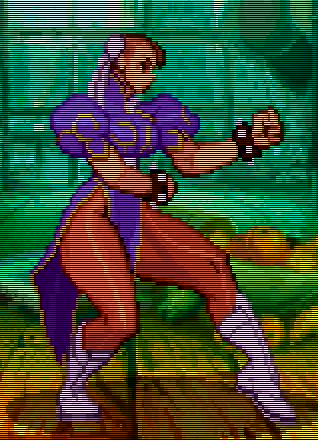
|

|
| This example was achieved by setting the Scanline to Gaussian and Scanline Str. to 50 in the Post-Processing section, and setting Prescale to 1/2 in the Interpolation/Deinterlacing section. | ||
Bob Scanline Modes
Much like pre-scaling for progressive content, Bob Scanline Modes gives you additional control for how scanlines are applied with 480i interlaced content. To use the various Bob Scanline options, the Deinterlacer must be set to "Bob" in the Interpolation / Deinterlacing menu, and scanlines should be enabled in the Post-Processing menu (any preferred combination of "+Scanline Beam" and "+Scanline Str." settings).
The "Post-Deint." or Post Deinterlace option applies scanlines after the 480i source has been deinterlaced to 480p. This gives the appearance of thinner scanlines.
"Pre-Deint. or "Pre-Deinterlace" treats the 480i source as 240p, so the applied scanlines are thicker. This is especially appropriate for situations where a 240p graphical asset game is being displayed in a 480i video mode.
The "CRT Simulate" setting functions similarly to Pre-Deinterlace, but shifts the odd and even scanlines every frame to reproduce how a CRT display would draw the image.
For more information on deinterlacing methods, please see the Interpolation/De-interlacing.
Below are some examples from Mega Man Anniversary Collection on the PlayStation 2. It is an example of a game that renders 240p assets through 480i video output. This is not typically a desirable combination for the best video quality, but using Bob Scanline modes and scanline Post Processing filters can help improve the visual experience of the game.
| Motion Adaptive (default) | Bob + Pre-Deint. | Bob + Post-Deint. |
|---|---|---|
| Bob + CRT Simulate | Bob + Pre-Deint. + Scanlines | Bob + CRT Sim. + Scanlines |
Saving and Loading Profiles
The RetroTINK-5X Pro includes 10 slots to save your custom settings. To save your settings, navigate to the [Save Profile] section from the Main Menu. Selecting one of the Save Profile slots (1-10) will save any current changes made to the RetroTINK-5X Pro system into the chosen slot.
As of firmware 2.98, selecting a slot to save a profile will bring up a secondary window allowing you to name your profile with an on-screen keyboard. The saved values can then be loaded from the Load Profile menu, or a slot be set to load on boot from the On-Screen Display/Startup Profile selection.
The Load Profile menu also allows you to go to the Default Profile; this isn't visible in the Save Profile menu to prevent the user from accidentally overwriting it. You can also load the Default Profile by quickly pressing the Back button on the remote six times.
Chroma Subsampling
Chroma subsampling is a technique used in video that reduces the data size of video information. It does this by compressing chroma (the color tone) separately from luma (the brightness) of a given pixel. This method takes advantage of the human eye’s ability to detect luma at a higher sensitivity as compared to chroma, and is a common practice in video reproduction to save on video bandwidth while minimizing degradation in quality.
A more detailed explanation of chroma subsampling can be found here.
The RetroTINK 5X operates using a YCbCr 4:2:2 chroma subsampling encoding. However, with sources up to 480p, a color fidelity comparable to YCbCr 4:4:4 is achieved through sampling the incoming video data at up to 3 times that of “traditional” capturing techniques - the ‘oversampled’ image is interpolated to produce much higher color accuracy than 4:2:2 alone.
With 720p and 1080i content, however, it isn’t possible to capture enough sample data for the “pseudo-4:4:4” technique to work, revealing color compression artifacts of the Tink’s baseline YCbCr 4:2:2 encoding. While there is nothing inherently “wrong” with using 720p and 1080i input content captured by the Tink, some users regard the 4:2:2 compression as suboptimal and may wish to find alternative methods of upscaling 720p and 1080i content.
Console Specific Configurations
This section goes over the specific settings and configurations you may want to consider for specific platforms, including their quirks such as the Nintendo 64's additional blur filters, or counteracting the 3DO's 480i output. Please keep in mind that the RetroTINK-5X Pro still provides a great experience without diving into any of this so that you can Just Play The Damn GameTM.
This section in particular delves into what is known as "Optimized Sampling". This process further refines the picture to gain the sharpest pixels possible by dialing in to the specific resolution the game is currently outputting. This comes at the expense of freely resizing the picture like in the Generic 4:3 and Generic 16:9 modes: doing this with Optimized Sampling will result in undesired results. This, combined with the pixel aspect ratios many retro games expected to be viewed on, means that Optimized Sampling is frequently at the mercy of integer-based scales. If that all sounds complicated, stick to the Generic 4:3 / 16:9 modes so you can resize to your heart's content.
The Optimized Sampling Settings in this section are transcribed from Wobbling Pixels' YouTube channel, where he creates excellent video guides to dial in optimal settings for various retro gaming consoles and configurations.
NES / Famicom
The Famicom (or Family Computer) is the original Japanese version of Nintendo's landmark console, while the NES (or Nintendo Entertainment System) was released in all other regions. All Famicom / NES systems will be marked as such at the front, so simply read that to tell which one yours is (particularly useful regarding the top-loading redesigns).
The NES / Famicom can only output either Composite video or RF (with one rare exception). Use the list below to tell which one your system outputs:
- Composite signals are supported by the RetroTINK-5X: insert the yellow cable into the green plug, then go to the "Input" menu and select "Composite".
- Original "Front-loading" NES.
- Top-loading "AV Famicom" with the rounded power switch and flat cartridge slot.
- Sharp's "Twin Famicom".
- Sharp's "Famicom Titler" (also capable of S-Video).
- RF signals are not normally supported by the RetroTINK-5X. For a workaround, visit the RF Consoles section below.
- Original Famicom w. hard-wired controllers.
- Revised "Top-loading" NES with a rounded cartridge slot and power switch.
- The RF Modulator output from the original "Front-loading" NES, which has softer sound compared to the the sharper Composite output.
Because these systems can only output Composite or RF, there's very limited room for the 5X to improve it. Here's our suggestions:
- Optimal sampling settings are the same as with the SNES / Super Famicom, so you can use the table provided in that section below. Because of Composite's low quality, it's subjective whether sharper look is better or not (see table below for examples).
- NES signals also tend to have some vertical jitter. This can be reduced by going to the "Interp./Deint." menu and setting "Vertical Filter" to "Soft".
- Certain titles would often have large parts of the screen that go unused, barely visible on a CRT but prominent on modern displays. To mask them out, go to the "Scaling/Crop" menu and use the Crop settings to adjust the Start and Ends of H Crop and V Crop.
| NES Composite Video Generic Vs Optimal Sampling Comparison | |
|---|---|
SNES / Super Famicom
| SNES / Super Famicom Optimal Settings | ||
|---|---|---|
| 1920x1080p (Fill) Output - NTSC | ||
| H. Sampling | Preset | SNES/PCE 256 |
| ADC Samp./Line | 1705 | |
| H (Interp) Size | +0% pix (1705) | |
| Allow Interlace | Disabled | |
| Scaling/Crop | H Position | +0 (176) |
| V Position | +3 (17) | |
| V Size | -3% (1047) | |
| 1920x1080p (Over) Output - NTSC | ||
| H. Sampling | Preset | SNES/PCE 256 |
| ADC Samp./Line | 2046 | |
| H (Interp) Size | +0% pix (2046) | |
| Allow Interlace | Disabled | |
| Scaling/Crop | H Position | +0 (-16) |
| V Position | -1 (35) | |
| V Size | +0% (1200) | |
| 2560x1440p Output - NTSC | ||
| H. Sampling | Preset | SNES/PCE 256 |
| ADC Samp./Line | 2048 | |
| H (Interp) Size | +0% pix (2387) | |
| Allow Interlace | Disabled | |
| Scaling/Crop | H Position | +0 (152) |
| V Position | -2 (23) | |
| V Size | +2% (1468) | |
| 1920x1080p (Fill) Output - PAL | ||
| H. Sampling | Preset | SNES/PCE 256 |
| ADC Samp./Line | 2046 | |
| H (Interp) Size | +0% pix (2046) | |
| Allow Interlace | Disabled | |
| Scaling/Crop | H Position | +0 (-38) |
| V Position | -6 (33) | |
| V Size | +8% (1244) | |
| 1920x1080p (Over) Output - PAL | ||
| H. Sampling | Preset | SNES/PCE 256 |
| ADC Samp./Line | 2046 | |
| H (Interp) Size | +0% pix (2046) | |
| Allow Interlace | Disabled | |
| Scaling/Crop | H Position | +0 (-38) |
| V Position | -6 (45) | |
| V Size | +8% (1244) | |
| 2560x1440p Output - PAL | ||
| H. Sampling | Preset | SNES/PCE 256 |
| ADC Samp./Line | 2048 | |
| H (Interp) Size | +0% pix (2387) | |
| Allow Interlace | Disabled | |
| Scaling/Crop | H Position | -32 (152) |
| V Position | -29 (41) | |
| V Size | +22% (1756) | |
For the vast majority of titles, the SNES' optimal settings are simple thanks to a specific preset. Go to "H. Sampling", set the Preset to "SNES/PCE 256", then reposition the image to the center of the screen in the "Scaling/Crop" menu by using the "V Position" option.
512 "Hi Res" Games
Certain games in the SNES' library used a "Hi Res" 512 pixels wide mode for certain layers. These were often used for higher resolution textures, or for increased text clarity in official Japanese titles or unofficial fan translations. Other games used it for transparency effects instead, such as Kirby's Dream Land 3.
Each will require a different approach:
- For games that use 512 pixels for transparency effects, use the following settings:
- In the "H. Sampling" menu, set "Preset" to "Generic 4:3"
- In the "Post Proc." menu, adjust the "Pre-emph" setting to "-5". You can use a higher Pre-emph setting if you're playing from a couch distance, or if your SNES has softer video output (see below).
- For games that use 512 pixels for higher resolution text and textures, use these settings:
- In the "H. Sampling" menu, set "Preset" to "HiRes 512".
- In the "Scaling/Crop" menu, there's a number in a white box: adjust the "V Size" setting until this number reads "1.00" (which means the pixel aspect ratio is correct). Then, adjust the V Position value to your preference.
| SNES 512 resolution examples | |||
|---|---|---|---|
1CHIP Vs 3CHIP Video Output
A quirk of earlier SNES models is a rightwards horizontal streaking of the image, resulting in a "murkier" picture. This effect is found to various degrees in all "3CHIP" SNES consoles, named after the numerical count of processors and video processing chips used on the console's main board. Later model SNES consoles have a revised design, and notably consolidated the CPU and video processors in a single package. These versions of the SNES are colloquially referred to as "1CHIP" consoles (this includes the slimmer SNES "Jr.", however the SNES Jr does not support RGB output without modding).
The "1CHIP" SNES design eliminated the horizontal streaking artifact, while increasing the overall brightness of the video output. The brightness boost is noticeably more vibrant, but without correction can "clip the whites" and cause some brighter details to be lost (the HD Retrovision SNES Cable has a selectable mode specifically for this issue). Despite the downsides, the "1CHIP" is still typically favored over "3-CHIP" models.
While the TINK-5X cannot completely remove the streaking found with "3CHIP" video output, it can help mitigate the effect somewhat:
- First, the optimized sampling numbers in the table above won't remove the blur, but will sharpen the edges of all pixels.
- Second, try setting the pre-emph to a positive value to apply a further sharpening effect.
- Third, try using a scanline preset in the 5X's "Post Proc." menu (and adjusting them further if you wish). This may help obfuscate the remaining blur.
| 3CHIP and 1CHIP video solutions | |||
|---|---|---|---|
Super Game Boy 8:7 Settings
| Super Game Boy Optimal Settings | ||
|---|---|---|
| 1920x1080p (Over) Output - NTSC | ||
| H. Sampling | Preset | Gen/Sat 320 |
| ADC Samp./Line | 1705 | |
| H (Interp) Size | -432 pix (1705) | |
| Allow Interlace | Disabled | |
| Scaling/Crop | H Position | +224 (-180) |
| V Position | -0 (34) | |
| V Size | +0% (1200) | |
| 2560x1440p Output - NTSC | ||
| H. Sampling | Preset | Gen/Sat 320 |
| ADC Samp./Line | 2046 | |
| H (Interp) Size | -519 pix (2046) | |
| Allow Interlace | Disabled | |
| Scaling/Crop | H Position | +272 (336) |
| V Position | +0 (21) | |
| V Size | +0% (1440) | |
If you're using the Super Game Boy, you'll want to use its own optimized sampling numbers when using it. This is because Game Boy games were expected to be displayed on the square pixels of a Game Boy screen, unlike the rectangular CRT pixels that the SNES expects. While not perfect squares, the 8:7 aspect ratio of the numbers provided above will give proportions that are much closer to an actual Game Boy, and so is a more accurate look. The Super Game Boy's borders however were intended to be shown on a CRT, and thus will look more accurate with the SNES optimized sampling numbers.
In the Pokémon Yellow examples below, note how the Pokéball in the game window is a perfect circle with the Super Game Boy's sampling but is squashed with the SNES' sampling. Meanwhile, the Pokéballs in the border are correct with the SNES' sampling.
| 8:7 Aspect Ratio Examples | |||
|---|---|---|---|
Nintendo 64
| Nintendo 64 Optimal Settings | ||
|---|---|---|
| 1920x1080p (Over) Output - NTSC | ||
| H. Sampling | Preset | N64 320 |
| ADC Samp./Line | 1934 | |
| H (Interp) Size | +0% pix (1934) | |
| Allow Interlace | Disabled | |
| Scaling/Crop | H Position | +0 (48) |
| V Position | +1 (33) | |
| V Size | -1% (1188) | |
| 2560x1440p Output - NTSC | ||
| H. Sampling | Preset | N64 320 |
| ADC Samp./Line | 2048 | |
| H (Interp) Size | +0% pix (2320) | |
| Allow Interlace | Disabled | |
| Scaling/Crop | H Position | +0 (48) |
| V Position | +1 (33) | |
| V Size | -1% (1425) | |
| H Crop Start | 468 | |
| H Crop End | 2344 | |
| V Crop Start | 78 | |
| V Crop End
|
1405 | |
| 4K Output - NTSC | ||
| H. Sampling | Preset | N64 320 |
| ADC Samp./Line | 2048 | |
| H (Interp) Size | +0% pix (3400) | |
| Allow Interlace | Disabled | |
| Scaling/Crop | H Position | +0 (200) |
| V Position | -8 (20) | |
| V Size | -2% (2116) | |
| H Crop Start | 476 | |
| H Crop End | 3508 | |
| V Crop Start | 38 | |
| V Crop End | 2169 | |
| 1920x1080p (Fill) Output - PAL | ||
| H. Sampling | Preset | N64 320 |
| ADC Samp./Line | 1986 | |
| H (Interp) Size | +0% pix (1986) | |
| Allow Interlace | Disabled | |
| Scaling/Crop | H Position | +0 (0) |
| V Position | -5 (32) | |
| V Size | +5% (1209) | |
| 2560x1440p Output - PAL | ||
| H. Sampling | Preset | N64 320 |
| ADC Samp./Line | 2048 | |
| H (Interp) Size | +64% pix (2384) | |
| Allow Interlace | Disabled | |
| Scaling/Crop | H Position | -76 (144) |
| V Position | -3 (15) | |
| V Size | +1% (1454) | |
| H Crop Start | 400 | |
| H Crop End | 2420 | |
| V Crop Start | 30 | |
| V Crop End | 1469 | |
| 4K Output - PAL (extreme widescreen crop) | ||
| H. Sampling | Preset | N64 320 |
| ADC Samp./Line | 2048 | |
| H (Interp) Size | 95% pix (3575) | |
| Allow Interlace | Disabled | |
| Scaling/Crop | H Position | -108 (92) |
| V Position | -5 (17) | |
| V Size | +1% (2181) | |
| H Crop Start | 472 | |
| H Crop End | 3476 | |
| V Crop Start | 2 | |
| V Crop End | 2169 | |
Similarly to the SNES, optimal sampling for the Nintendo 64 is simple thanks to a preset just for it that works for many games in its library. Simply go to "H. Sampling", set the Preset to "N64 320", then go to the "Scaling/Crop" menu to center the image.
Counteracting N64 Anti-Aliasing
The Nintendo 64 uses an anti-aliasing (AA) effect to smooth the picture and reduce the appearance of hard pixel edges and dithering. Users that prefer a sharper look have the option to disable the N64's AA with GameShark codes, or by patching the game ROM. More information regarding methods to disable AA can be found here.
The RetroTINK-5X Pro's optimal Nintendo 64 sampling can also greatly increase the sharpness of the image, and can be used in conjunction with the disable-AA methods for the sharpest possible picture. For many, optimal sampling alone may provide results equivalent to an Anti-Aliasing patch.
The following examples are from Mario Kart 64, using S-Video cables in the Peach example and RGB cables in the Track example. The images show the RetroTINK-5X Pro's generic and N64 optimal sampling modes, as well as with and without disable-AA patches applied.
| Nintendo 64 Anti-Aliasing Comparisons | |||
|---|---|---|---|
| Generic Sampling | Optimal Sampling | Generic Sampling | Optimal Sampling |
|
|
|
|
|
More info and video examples can be found in the following Wobbling Pixel's Video:
GameCube
GBA Player
The GameCube supports a peripheral called the GBA Player, which allows Game Boy Advance games to be played via a GameCube, similar to the Super Game Boy on a SNES. However, the GBA Player used software with a blurry and otherwise undesirable video output. To get around this, many players use an SD card and SWISS to load a replacement program known as the Game Boy Interface, which has a much improved video output. The Wobbling Pixels video above shows how to get this working on your GBA Player.
When the RetroTINK-5X detects the 360p output of the Game Boy Interface, a special "GBI Optimal" Preset can be found and selected in the "H. Sampling" menu. This automatically enables optimized sampling just for the Game Boy Interface.
For a more authentic look, you may want to consider enabling the LCD Scanlines preset in the "Post Proc." menu, which overlays a thin pixel grid that looks a lot like a Game Boy Advance screen. Keep in mind however that due to their thin width, LCD Scanlines only display correctly for GBI when using the 1080p (Fill), 1200p and 1440p Output Resolutions.
Sega Genesis / Mega Drive
For practicality, "Genesis" refers to both the Sega Genesis and the Mega Drive (its Japanese and European name), as they are functionally identical as far as the RetroTINK-5X is concerned, outside of NTSC and PAL standards.
The Sega Genesis has three "240p" output resolutions. The fourth, 480i, is only known to be used in the 2 Player VS modes of Sonic the Hedgehog 2 and Combat Cars. Select these presets in the 5X's "H. Sampling" menu:
- Most Genesis games run at 320x224. For these, use "Gen/Sat 320".
- Other titles run at 256x224. For these, "SNES/PCE 256" should be used.
- You can additionally set the "ADC Samp./Line" setting to 1710. The Console Clock reading should read "342.00/line", which may or may not provide some extra sharpness for these games compared to the preset.
- Interlaced resolutions (like in Sonic 2) can use the presets described above, since only the vertical resolution is doubled. Be sure to set "Allow Interlace" to "Enabled" so that the presets will be applied to 480i.
Once you've chosen the correct preset, make sure to go to the "Scaling/Crop" menu and adjust the "V Position" value to center the image.
CRAM Dots
Certain Genesis games will display colored dots along the bottom edge of the screen. Known as CRAM (Colour RAM) dots, these would have been in the overscan area of most CRTs and thus invisible to the player, but are quite prominent on modern displays. If you find them unsightly, the 5X has a way to hide them:
- Go to the "Scaling/Crop" menu, then lower the "V Crop End" value until CRAM dots are no longer visible.
Genesis Dithering
Genesis games make extensive use of dithering in tandem with composite video and CRT displays to simulate transparency and blend colours together (such as the waterfalls in Sonic the Hedgehog). These effects disappear when using devices like the 5X and higher-quality signals like S-Video and SCART, but they can be "restored" with this specific setup:
- In the "H. Sampling" menu, use the "Generic 4:3" preset.
- In the "Post-Proc." menu, adjust the "Pre-emph" setting to a negative value to add blur. This may be all that's needed to satisfy your tastes!
- In the "Output Res." menu, pick 720p. This will remove the dithering almost completely, at the expense of a rather blurry picture.
- You can further use some of the scanline and mask options in the "Post Proc." menu to disguise the blurriness of the picture.
Sega Saturn
Since the Saturn has only three possible output resolutions, figuring out optimal settings is similar to the Genesis. You can select these presets in the 5X's "H. Sampling" menu:
- Most Saturn games run at 320x224. For these, use "Gen/Sat 320".
- Other titles run at 352x224 (such as the Capcom Arcade ports, Panzer Dragoon 1, et al). For these, "Saturn 352" should be used.
- Interlaced resolutions (like in Virtua Fighter 2) require one of two solutions, depending on the 5X's output resolution:
- For 1080p, use "HiRes 858", then set the "ADC Samp./Line" setting to 1820. The Console Clock reading should read "910.00/line".
- If you're using the 5X's experimental 1440p output resolution, use "Generic 4:3". This is because the Saturn's 910 samples per line cannot be achieved at 1440p, so optimal sampling won't present it nicely.
Once you've gotten the right H. Sampling preset, go to the "Scaling/Crop" menu and adjust the "V Position" value to center the image.
Saturn Dithering
Saturn games, like the Genesis before it, frequently use dithering in tandem with composite video and CRT displays to simulate transparency and blend colours together. These effects disappear when using devices like the 5X and higher-quality signals like S-Video and SCART, but they can be "restored" with a specific setup:
- In the "H. Sampling" menu, use the "Generic 4:3" preset.
- In the "Post-Proc." menu, adjust the "Pre-emph" setting to a negative value to add blur. This may be enough to satisfy your tastes!
- In the "Output Res." menu, pick 720p. This will remove the dithering almost completely, at the expense of a rather blurry picture.
- You can further use scanlines and masks in the "Post Proc." menu to disguise the blurriness of the picture.
Dreamcast
| Dreamcast Optimal Settings | ||
|---|---|---|
| 1920x1080p (Under) Output | ||
| H. Sampling | Preset | DTV 858-A |
| ADC Samp./Line | 1716 | |
| 1200p Output | ||
| H. Sampling | Preset | Generic 3:2 |
| ADC Samp./Line | 2048 | |
| Post Proc. | Pre-emph | +1 |
If you're using the Dreamcast's VGA output, optimal sampling is made easy since there are easy presets just for it in the "H. Sampling" menu, which will work for most of its games library. Which one you pick depends on the output set in the 5X's "HDMI" menu.
- If your output is 1080p (Under), choose the "DTV 858-A" Preset.
- If your output is 1200p, choose the "Generic 3:2" Preset. You should also go to the "Post Proc." menu and set the Pre-emph to +1, which sharpens the image a bit.
Dreamcast VGA on the 5X
The highest quality video output of the Sega Dreamcast without modding is VGA (31Khz RGBHV). Most games on the Dreamcast support VGA output, and workarounds exist to extend the feature to even more titles (such as patches and the "force VGA" functions of the optical drive emulators GDEMU and MODE). A chart showing Dreamcast VGA compatibility can be found here. Old Kid's Note: We should convert that guide to the wiki!
Currently two kinds of options exist to bring VGA signals into the RetroTINK-5X Pro, 'Sync Combiner Boxes' and a 'Sync Combiner "All-in-One" Cable':
Sync Combiner Boxes
The RetroTINK-5X Pro requires that the Dreamcast's VGA signal be converted (RGBHV sync-combined to RGBs) to work with the 5X's RGB-SCART input. Thankfully, devices such as the HD15-2-SCART, VGA2SCART can make that conversion.
Note that both the HD15-2-SCART and VGA2SCART will require existing VGA and audio cables from the Dreamcast's output. The Retro-Bit Dreamcast VGA Cable is an inexpensive, respectable quality option to get VGA and stereo sound from the Dreamcast, but generic "Dreamcast VGA Cables" and dedicated "VGA Boxes" can work similarly.
Once the Dreamcast is connected to either sync combiner box, The HD15-2-SCART plugs directly into the SCART input on the RetroTINK-5X Pro, while the VGA2SCART will require a male-to-male SCART adapter (such as the one linked here) or a "male-end to male-end SCART cable" to make the connection.
The HD15-2-SCART provides a switch to enable/disable the sync combining feature (which possibly could be a benefit when using with other devices that support RGBHV over SCART) while the VGA2SCART's sync combiner feature is 'always on'.
A note concerning audio - Both HD15-2-SCART and VGA2SCART receive audio over a stereo 1/8" TRS jack, so "Retro-Bit Style" VGA cables will require a Stereo RCA to 1/8" TRS adapter for audio to be routed into the boxes.
The benefit of using the "Sync Combiner Box" solution is flexibility. While the RetroTINK-5X Pro isn't specifically designed to process other VGA inputs and compatibility isn't guaranteed, using a "Sync Combiner Box" can give you the option to plug in other VGA sources, or to use the Box with other devices or video processors.
Sync Combiner "All-in-One" Cable
The Retro Access 15Khz/31Khz Dreamcast Cable and Sega Dreamcast PACKAPUNCH RGB 480p SCART cable are all-in-one "VGA to SCART" cables for the Dreamcast that do not require any additional hardware. The sync combiner circuit is built into the cable and unlike the "Sync Combiner Boxes", they won't work with any other device than the Dreamcast. Both cables feature the function to switch between 15Khz and 31Khz RGBs signal output, providing the option of outputting 480p or 480i video modes. While 480p is typically preferred as the higher quality video mode, the RetroTINK-5X Pro can accept and process both outputs.
| Dreamcast "VGA" Examples | ||
|---|---|---|
PlayStation 1
| PlayStation 1 Optimal Settings | ||||||
|---|---|---|---|---|---|---|
| 1920x1080p (Fill) Output - NTSC | ||||||
| 256p | 320p | 384p | 512p | 480i | ||
| H. Sampling | Preset | SNES/PCE 256 | PS1 320 | PS1 384 | HiRes 512 | |
| ADC Samp./Line | 1705 | 1706 | 1950 | 2046
|
||
| H (Interp) Size | +1 pix (1706) | +0 pix (1706) | +0 pix (1950) | +1 pix (2047) | ||
| Allow Interlace | Disabled | Disabled | Disabled | Disabled | ||
| Scaling/Crop | H Position | +0 (176) | +0 (172) | +0 (36) | +0 (-12) | |
| V Position | +3 (17) | +3 (17) | -11 (31) | -17 (37) | ||
| V Size | -3% (1047) | -3% (1047) | +11% (1198) | +17% (1263) | ||
| 1920x1080p (Over) Output - NTSC | ||||||
| 256p | 320p | 384p | 512p | 480i | ||
|
H. Sampling |
Preset | SNES/PCE 256 | PS1 320 | PS1 384 | HiRes 512 | |
| ADC Samp./Line | 2046 | 2048 | 1950 | 2046
|
||
| H (Interp) Size | +1 pix (2047) | +0 pix (2133) | +0 pix (1950) | +1 pix (2047) | ||
| Allow Interlace | Disabled | Disabled | Disabled | Disabled | ||
| Scaling/Crop | H Position | +0 (-16) | +0 (-60) | +0 (36) | +0 (-12) | |
| V Position | -7 (41) | +0 (34) | +0 (34) | -5 (39) | ||
| V Size | +5% (1260) | +0% (1200) | +0% (1200) | +5% (1260) | ||
| 2560x1440p Output - NTSC
| ||||||
| 256p | 320p | 384p | 512p | 480i
| ||
| H. Sampling | Preset | SNES/PCE 256 | PS1 320 | PS1 384 | HiRes 512 | |
| ADC Samp./Line | 2048 | 2048 | 2048 | 2048
|
||
| H (Interp) Size | +2 pix (2389) | +0 pix (2560) | +0 pix (2437) | +2 pix (2730) | ||
| Allow Interlace | Disabled | Disabled | Disabled | Disabled | ||
| Scaling/Crop | H Position | +0 (152) | +0 (64) | +0 (130) | +0 (16) | |
| V Position | -6 (27) | -13 (34) | -4 (25) | -17 (38) | ||
| V Size | +2% (1468) | +9% (1569) | +4% (1497) | +17% (1684) | ||
| 1920x1080p (Fill) Output - PAL
| ||||||
| 256p |
320p |
384p | 512p | 480i | ||
| H. Sampling | Preset | SNES/PCE 256 | PS1 320 | PS1 384
|
HiRes 512 | HiRes 858 |
| ADC Samp./Line | 2043 | 2048 | 1946 | 2043 | 1702 | |
| H (Interp) Size | +0 pix (2043) | +0 pix (2129) | +0 pix (1946) | +0 pix (2043) | +0pix (1702) | |
| Allow Interlace | Disabled | Disabled | Disabled | Disabled | Enabled | |
| Scaling/Crop | H Position | +0 (-38) | +0 (-82) | +0 (18) | +0 (-32) | +0 (148) |
| V Position | -10 (37) | -14 (41) | -10 (37) | -10 (37) | +8 (19) | |
| V Size | +8% (1244) | +13% (1301) | +3% (1186) | +8% (1244) | +0% (1152) | |
|
2560x1440p Output - PAL | ||||||
| 256p |
320p |
384p | 512p | 480i | ||
|
H. Sampling |
Preset | SNES/PCE 256 | PS1 320 | PS1 384 | HiRes 512 | HiRes 858 |
| ADC Samp./Line | 2043 | 2048 | 2048
|
2048 | 1702 | |
| H (Interp) Size | -3 pix (2384) | +0 pix (2554) | -5 pix (2432) | -4 pix (2724) | +0 pix (1702) | |
| Allow Interlace | Disabled | Disabled | Disabled | Disabled | Enabled | |
|
Scaling/Crop |
H Position
|
+0 (184) | +0 (88) | +0 (166) | +0 (16) | +0 (148) |
| V Position | -5 (17) | -13 (25) | -15 (27) | -26 (38) | -5 (32) | |
| V Size | +1% (2384) | +8% (1555) | +3% (1483) | +15% (1656) | +10% (1267) | |
Optimal sampling on the PlayStation 1 is a very complicated affair, because it has a large number of possible output resolutions, meaning you can't just "set it and forget it". Instead, you'll almost certainly need to set up and use multiple Profiles that accommodate for the various output resolutions the games in your library may have.
- We highly recommend checking the output resolution of each of your PlayStation 1 games so that you only have the Profiles you actually need.
- You should also commit to which output resolutions you want to use: trying to accommodate for all of them would require 30 or more Profiles!
Further, pixel aspect ratio will be incorrect for many combinations, due to the region of the game, the H.Sampling preset and the 5X's output resolution. If you want to use optimal sampling, read over the table above carefully to make sure you're picking the right preset, and using the right "H (Interp) Size" numbers and "V Size" numbers.
- For V-Size, look for the number in the white box in the bottom-right corner of the Scaling/Crop window: when this reads "1.00", you've matched the intended pixel aspect ratio!
Resolution Switching
The PlayStation 1 library occasionally uses more than one output resolution within the same game. One of the most famous examples is Chrono Cross, where gameplay is in 240p while the pause menus are in 480i (hence the common name, "The Chrono Cross Problem"). While resolution switching worked fine on the CRTs that the PS1 expected to output to, almost all modern flat-panel displays, as well as many capture cards, take some time to switch, resulting in several seconds of no display at all. This pause can not only be frustrating, but risky when returning to gameplay, where you'll be blind to all threats until the image returns.
The RetroTINK-5X has two methods to get around this, both located in the HDMI menu:
- Setting the V-Sync to either Triple Buffer or Gen Lock is usually enough to alleviate the issue, at the cost of a hair of input lag.
- If you're still encountering this issue (particularly in PAL games), also setting "Lock to 60 hz" to On will often solve the issue entirely.
It's worth noting that the TINK-5X is not able to automatically switch its H. Sampling Preset when the resolution changes. Thus, we recommend using the Preset that matches the gameplay resolution and sticking with that. Using Generic 4:3 is also an option, although the image will of course not be quite as sharp as optimal sampling.
PlayStation 2
| PlayStation 2 Optimal Settings | |||||||
|---|---|---|---|---|---|---|---|
| 1920x1080p (Fill) Output - NTSC
| |||||||
| 256p |
320p |
384p | 512p | 512x576i | 640x576i | ||
| H. Sampling | Preset | SNES/PCE 256 | PS1 320 | PS1 384 | HiRes 512 | HiRes 512 | HiRes 858 |
| ADC Samp./Line | 1705 | 1706 | 1950 | 2046 | 2046 | 1716 | |
| H (Interp) Size | +11 pix (1716) | +9 pix (1715) | +10 pix (1960) | +13 pix (2059) | +14 pix (2060) | +0 pix (1716) | |
| Allow Interlace | Disabled | Disabled | Disabled | Disabled | Enabled | Enabled | |
| Scaling/Crop | H Position | +0 (176) | +0 (172) | +0 (36) | +0 (-12) | -16 (-32) | +0 (168) |
| V Position | -2 (22) | +2 (18) | -12 (32) | -17 (37) | -14 (35) | +2 (10) | |
| V Size | -2% (1058) | -2% (1058) | +12% (1209) | +17% (1263) | +12% (1612) | -2% (1058) | |
| 1920x1080p (Over) Output - NTSC | |||||||
| 256p | 320p | 384p | 512p | 512x576i | 640x576i | ||
| H. Sampling | Preset | SNES/PCE 256 | PS1 320 | PS1 384 | HiRes 512 | HiRes 512 | HiRes 858 |
| ADC Samp./Line | 2046 | 2048 | 1950 | 2046 | 2046 | 1716 | |
| H (Interp) Size | +13 pix (2059) | +11 pix (2144) | +10 pix (1960) | +13 pix (2059) | +14 pix (2060) | +0 pix (1716) | |
| Allow Interlace | Disabled | Disabled | Disabled | Disabled | Enabled | Enabled | |
| Scaling/Crop | H Position | +0 (-16) | +0 (-60) | +0 (36) | +0 (-12) | -16 (-32) | +0 (168) |
| V Position | -9 (43) | +0 (34) | -1 (35) | -6 (40) | -14 (35) | +2 (10) | |
| V Size | +6% (1271) | +0% (1200) | +1% (1212) | +6% (1271) | +12% (1612) | -2% (1058) | |
| 2560x1440p Output - NTSC | |||||||
| 256p | 320p | 384p | 512p | 512x576i | 640x576i | ||
| H. Sampling | Preset | SNES/PCE 256 | PS1 320 | PS1 384 | HiRes 512 | HiRes 512 | HiRes 858 |
| ADC Samp./Line | 2048 | 2048 | 2048 | 2048 | 2048 | 2048 | |
| H (Interp) Size | +17 pix (2404) | +14 pix (2574) | +13 pix (2450) | +17 pix (2745) | +18 pix (2746) | +0 pix (2574) | |
| Allow Interlace | Disabled | Disabled | Disabled | Disabled | Enabled | Enabled | |
| Scaling/Crop | H Position | +0 (152) | +0 (64) | -0 (130) | +0 (-16) | +0 (-16) | +0 (56) |
| V Position | -8 (29) | -11 (32) | -5 (26) | -17 (38) | -13 (25) | -15 (36) | |
| V Size | +3% (1483) | +10% (1584) | +5% (1511) | +17% (1684) | +17% (1684) | +10% (1584) | |
| H Crop End | 2352 | 2388
|
2352 | 2352 | 2484 | 2452 | |
| 1920x1080p (Fill) Output - PAL | |||||||
| 256p | 320p | 384p | 512p | 512x576i | 640x576i | ||
| H. Sampling | Preset | SNES/PCE 256 | PS1 320 | PS1 384 | HiRes 512 | HiRes 512 | HiRes 858 |
| ADC Samp./Line | 2046 | 2048 | 1950 | 2046 | 2046 | 1728 | |
| H (Interp) Size | +27 pix (2073) | +32 pix (2161) | +27 pix (1977) | +27 pix (2073) | +28 pix (2074) | +0 pix (1728) | |
| Allow Interlace | Disabled | Disabled | Disabled | Disabled | Enabled | Enabled | |
| Scaling/Crop | H Position | +0 (-38) | -8 (-90) | -24 (-6) | +0 (-32) | +0 (-32) | +0 (148) |
|
V Position |
-12 (39) | -14 (41) | -10 (37) | -10 (37) | -1 (28) | +0 (27) | |
| V Size | +10% (1267) | +14% (1313) | +5% (1209) | +10% (1267) | +10% (1267) | +0% (1152) | |
|
2560x1440p Output - PAL | |||||||
| 256p | 320p | 384p | 512p | 512x576i | 640x576i | ||
| H. Sampling | Preset | SNES/PCE 256 | PS1 320 | PS1 384
|
HiRes 512 | HiRes 512 | HiRes 858 |
| ADC Samp./Line | 2048 | 2048 | 2048 | 2048
|
2048 | 2048 | |
| H (Interp) Size | +31 pix (2418) | +39 pix (2593) | +35 pix (2472) | +37 pix (2765) | +37 pix (2765) | +0 pix (2592) | |
| Allow Interlace | Disabled | Disabled | Disabled | Disabled | Enabled | Enabled | |
| Scaling/Crop | H Position | +0 (184) | -48 (40) | -60 (106) | -40 (-24) | +0 (-16) | +0 (80) |
| V Position | -6 (18) | -16 (28) | -16 (28) | -27 (39) | -13 (25) | -10 (22) | |
| V Size | +3% (1483) | +10% (1584) | +5% (1511) | +17% (1684) | +17% (1684) | +10% (1584) | |
The PlayStation 2 is a particularly hairy system because it has one of the highest number of possible output resolutions of any games console. This is because in addition to its two "480" resolutions for PS2 games, it also inherits the four 240p resolutions for PS1 games.
- We strongly recommend researching what resolutions your PS1 and PS2 games output so that you aren't using any unneeded Profile slots.
- There are two possible resolutions that can be output by PS2 games, so they only require two Profiles total. If you're unsure of what resolution your game runs at, just set up a Profile for both and chose the one that looks correct.
- Also remember to enable the "Allow Interlace" option in the H. Sampling menu, otherwise optimized sampling will not appear on interlaced resolutions!
- The PlayStation 2's "240p" resolutions require different numbers than the PlayStation 1, due to the different clock speed. We advise users with both a PlayStation 1 and 2 to play PS1 games on a PS1, to keep the needed Profiles to a minimum.
The major sticking point with PS2 games however is that the vast majority of them can only output interlaced video: 480i. Some games allow you to use a button combination when the game boots to enter a progressive output mode, or in the options menu, but few games allow for this, and the button combo trick doesn't exist in PAL games.
No deinterlacing solution will be perfect, since interlacted footage is inherently "missing" half the picture at any given "frame". That said, the RetroTINK-5X offers several deinterlacing methods:
- Motion Adapt. is the most appealing option, using a combination of Weave and Blend to make a progressive-like result. This is very similar to the deinterlacing used on real CRTs that supported it.
- Weave and Blend leave visible motion artifacts: combs for Weave and ghosting for Blend. Blend's ghosting looks like frame interpolation in rendered videos, and thus may not even be noticeable to you.
- Bob and Smooth-Bob will shift every "frame" up and down to form the picture. This can look very distracting for some players.
- If you want to get creative, you can also replicate real CRT behaviour by setting "Bob Scanline" to "CRT Simulate". Then, go to the "Post. Proc" menu and use one of the Scanline Beam settings. This will approximate the blank scanlines that would appear on a real CRT displaying 480i, and thus may appear more familiar.
- If the Motion Adapt, Blend or Bob methods appear like Weave, go to the "HDMI" menu and make sure that "Lock to 60 HZ" is set to "Off".
PlayStation Portable (PSP)
| PlayStation Portable Optimal Settings
| |||
|---|---|---|---|
|
1920x1080p (Over) Output | |||
| No Scanlines | Scanlines | ||
|
H. Sampling |
Preset | Generic 4:3 | Generic 4:3
|
| ADC Samp./Line | ???
|
??? | |
| H (Interp) Size | +72% (3354) | +74% pix (3393) | |
| Allow Interlace | Disabled | Disabled | |
| Scaling/Crop | H Position | -412 (-412) | -420 (-420) |
| V Position | -85 (145) | -86 (146) | |
| V Size | +58% (1896) | +60% (1920) | |
In the Optimal Settings above, "No Scanlines" will stretch the image to fill your display while maintaining the PSP's 30:17 aspect ratio. The "Scanlines" setting meanwhile adjusts the picture slightly so that scanlines are drawn correctly (particularly LCD scanlines), but the aspect ratio will be slightly incorrect. In either case, sometimes the H Position and V Position values won't line up correctly, so we recommend manually adjusting these yourself so that the picture is centered on your display.
The specific model of PSP you're using will determine whether it's capable of video out, and to what extent:
- The original PSP model (PSP-1000) and the PSP Street (PSP-E1000) do not support video out.
- The PSP-2000 is capable of video out, but with restrictions. Composite and S-video cables can display most types of content playable from the XMB (photos, music, videos) as well as UMD movies and PS1 titles, but component cables are required for PSP games and the occasional Sony Extras app (e.g. SensMe, Digital Comics).
- The PSP-3000 uses the same video out cables as the PSP-2000 but can now output PSP games in interlace mode, meaning all content on the PSP can now be displayed with any cable.
- The PSPgo uses different cables than the PSP-2000 but is otherwise just as capable as the PSP-3000 (i.e. PSP games can be displayed in interlace mode using composite or S-video cables). The dock is not necessary for video output, but it is necessary to enable video output and charge the PSPgo at the same time, short of modifying a PSPgo video out cable.
We highly recommend you use Component Cables when using a PSP-3000 / Go with the RT5X. While the 5X works with PSP Composite and S-Video signals just fine, because the video output is so small within the 480p frame, it's not possible for the 5X to fill the entire screen with PSP output on anything except Component.
PSone Classics
It's possible for PSone Classics running on a PSP to output at their native 240p resolution. To enable this, on your PSP navigate to Settings > Connected Display Settings, then set the "Component / D-Terminal Output" setting to Interlaced. This will result in a sharper picture through the TINK-5X than the Progressive option.
However, you cannot use either the PS1 or PS2 Optimal Sampling numbers from earlier on this page, as they work incorrectly with the PSP's 240p output. For now, we suggest using the "Generic 4:3" H. Sampling preset with the "1080p (Fill)" Output, or using real PS1/PS2 hardware.
PlayStation TV + Sharpscale Hack
The PlayStation TV (known as the Vita TV in Japan) is a popular way to play digital PSP, Vita and PSone Classic games on a TV, thanks to its compact size and compatibility with DualShock 3 and 4 controllers. However, it does not correctly display or upscale its picture, and adds a bilinear filter to all video output by default. You can however use a popular homebrew plugin called the Sharpscale Hack by Cuevavirus to open up new options, and combine it with the 5X to get a pixel perfect upscale of PSP, Vita and PSone Classics games. First though, two notes:
- The Sharpscale Hack is a plugin for a homebrew firmware called h-encore2, which you'll need to have installed in order for this to work. Without it, there's no benefit routing the signal through the 5X.
- Since the PSTV can only output via HDMI (which the 5X cannot accept), you'll need to convert the HDMI signal to component, as detailed in the "HDMI consoles" section further below. Make sure to read this section carefully, as high-definition signals are not the initial intended use case for the 5X.
PSVita and PSP Games
| PSTV Sharpscale - PSP and PSVita Optimal Settings | ||
|---|---|---|
| H. Sampling | Preset | Generic 16:9 |
| ADC Samp./Line | 2048 | |
| H (Interp) Size | 0% (2200) | |
| Scaling/Crop | H Position | -4 (-50) |
| H Crop Start | 176 | |
| Interp./Deint | Vertical Filter | Sharp |
| Deinterlacer | Bob | |
| Bob Offset | -1 | |
Here's how to set up the Sharpscale Hack and the RetroTINK-5X when playing PSP and Vita games on PSTV (PSone Classics have their own section below):
- First, in the Sharpscale Configuration Menu app, set Scaling to "integer" and Filter to "point".
- Set the PSTV's output resolution to 1080i. With the above Sharpscale settings, this will fill the screen for Vita and PSP games, at the cost of cropping out 4 pixel rows each on the top and bottom of the screen.
- On the RetroTINK-5X, apply the optimal sampling settings in the table above.
| PSTV - Vita / PSP Sharpscale Comparison | |||
|---|---|---|---|
PSone Classics
| PSTV Sharpscale - PSone Classics 480p Optimal Settings | ||
|---|---|---|
| Output Res. | Output Resolution | 1080p (Fill) |
| H. Sampling | Preset | Generic 4:3 |
| ADC Samp./Line | 1950 | |
| H (Interp) Size | 0% (1950) | |
| Interp./Deint | Vertical Filter | Sharp |
| Pre-scaler | 1/2 | |
Because of the unique resolutions of PSone Classics and the limitations of the PSTV, these titles have to be handled differently compared to PSP and Vita games. There are many different combinations you can try for the PSTV and RT5X's resolutions; here are our two recommendations:
- The PSTV can output 480p, which is a natural fit for the 5X:
- Set the PSTV to output 480p (2x the resolution of PSone Classics)
- In the 5X, go to the "Interp./Deinterp" menu and set the Pre-scaler to 1/2 (half).
- Apply the Optimal Settings listed in the table above, then go to the "Scaling/Crop" menu and adjust the position and cropping to your preference.
- Alternatively, the PSTV's 720p output allows for clean scaling to 1440p:
- Set the PSTV to output 720p (3x the resolution of PSone Classics)
- Go to the 5X's "Interp./Deinterp" menu and set the Pre-scaler to 1/3 (a third).
- In the 5X's OSD menu, make sure "Advanced Res." is set to "Yes".
- In the 5X's Output Res. menu, select "2560x1440".
- In all cases, in the Sharpscale Configuration Menu app, set the PS1 Aspect Ratio to "4:3". This will ensure the correct aspect ratio at all times, but at the cost of uneven pixel scaling that is only apparent in 2D games.
- PSone games cannot be played in 1080i: if you attempt this, the PSTV will switch to 720p until the game is close. As a result, you may need to swap between two different PSTV output resolutions and 5X Profiles.
| PSTV - PSone Classic Sharpscale Comparison | |
|---|---|
3DO
Optimal Settings
| 3DO Optimal Settings (doujindance 240p over RGB) | ||
|---|---|---|
| 1920x1080p (Fill) Output - NTSC | ||
| H. Sampling | Preset | N64 320
|
| Phase Detect | Auto | |
| Lock Speed | Fast | |
| ADC Samp./Line | 1934 | |
| H (Interp) Size | +56 pix (1990) | |
| Allow Interlace | Enabled | |
| Scaling/Crop | H Position | +0 (24) |
| V Position | -9 (29) | |
| H (Interp) Size | +56 pix (1990) | |
| V Size | +11% (1198) | |
| H Crop Start | 332 | |
| H Crop End | 1924 (% 4:3) | |
| V Crop Start | 24 (1.02) | |
| V Crop End | 1103 | |
| Video ADC | SDTV LPF | Off |
| EDTV LPF | Off | |
| SoG Thresh | 120 mV | |
| LLPLL Gain | 0 | |
| LLPLL BW | 0 | |
| Pre-Coast | 1 | |
| Post-Coast | 1 | |
| ADC Phase | 180.00 Deg | |
3DO 240p Video Output Methods
The 3DO internally renders to a 320x240@16bpp frame buffer then using a proprietary "corner weight color averaging interpolation" algorithm and Color Lookup Table upscales the image to 640x480@24bpp. That upscaled image carved up by the CLIO chip and fed to the DAC which requests an even or odd field. The 3DO software has the ability to enable interpolation on the horizontal, vertical, both, or neither (which is also known as "crispy pixels.") More about the 3DO rendering pipeline can be found on 3dodev.com.
While the "corner weight color averaging" algorithm used in some games gives increased color depth and smooths the image, some may prefer the less flickery and sharper native 240p output.
Some "FZ-1" 3DOs from Japan have a special Mode Select switch on the back in place of the RF output, which allows switching between Mode A, standard 480i output, and Mode B, native 240p video output. Use of Mode B can also cause some games to have their game logic run twice the intended rate due to bug in how a vblank counter is used. This can make some games nearly unplayable. The Juxtaposition Image below demonstrates the visual difference between 480i and 240p from a 3DO featuring the "Mode Select" switch.
"Pseudo-240p" With The RetroTINK-5X Pro
If you don't have a 3DO with a Mode Select switch, or don't want the possible side-effects of setting one to Mode B, the RetroTINK-5X Pro offers a deinterlacing method that can simulate a 240p look with a 3DO with no Mode Select at all: "Pre-Deinterlacing" Bob Scanlines.
- To accomplish this Pseudo-240p method, go to the TINK-5X's "Interp./Deint." menu and adjust the following settings:
- Deinterlace Method: Bob
- Bob Scanline: Pre-Deint.
This will effectively ignore half of the 480i video lines and scale the image as a "pseudo-240p" source.
It's worth noting that not all games will see a visible improvement with this method. Titles that do not use the "corner weight color averaging interpolation" feature will look almost identical between "240p" and "Motion Adaptive" modes, whereas games that do use the color interpolation effect may have a beneficial sharpened look in "240p" processing mode. See the table below for examples. More info concerning the "corner weight color averaging interpolation" algorithm can be found at 3dodev.com
| 3DO Special Processing Examples | |||
|---|---|---|---|
Below are some comparisons between the RetroTINK-5X Pro's Bob Scanline Pre-Deint mode and a special model 3DO that has a 240p / 480i switch built in:
| 3DO "Real 240p" Vs. "Pseudo-240p" | ||
|---|---|---|
RF Consoles
Before Composite and later video signal formats, many video game systems used radio frequency (RF) signals to output video and audio to televisions, including the Super Famicom and systems released before it.- One unique usecase is the NES, which has softer audio through the RF Modulator, which some may prefer over the sharper audio of the NES's Composite audio output.
The RetroTINK-5X Pro does not accept RF signals directly, however it is possible to use an RF demodulator to pass composite video and RCA audio to the RetroTINK-5x's inputs. While other methods exist, the most common and cheapest RF Demodulator is a standard consumer VCR (pictured right).
As of this writing, VCRs can still commonly be found in second-hand stores. Make sure the model you intend to use has both RF Inputs (typically labeled as Antenna In) and Composite Outputs (the Yellow, Red and White output jacks for the video and audio), indicating that the VCR supports RF Demodulation.
- Note that it is not typically required for the VHS tape playback hardware be functional to use the demodulator features. However the RetroTINK-5X can act as a VHS upscaler so that you can watch VHS tapes on a modern display.
Two common types of cables to connect the console to the VCR are RF Switch Boxes and RCA to F-Type "RF Direct" Connectors:
| Cables to Connect Console To VCR | |
|---|---|
Your console might have one or the other, and either connection method is an acceptable way to interconnect the console and VCR. Note that some console has an RCA end but does not have an F-Connector adapter to plug into the VCR, and will need an inexpensive "RCA Female to F-Type Male" adapter to plug in. Here is a link to an Amazon search that should point you in the right direction.
RF switch boxes often came standard with older consoles because they allow daisy chaining of RF inputs into one TV coax jack, with a toggle allowing one to switch between the console's output and a cable TV / antenna connected to the switch box.
Note that video game systems most often broadcast their signal over channels 3 or 4, and many times contain a switch to select between the two channels. There’s no reason to choose one over the other, but take note of the channel your console is set to, as the VCR will need to be set to that channel to receive the console's signal.
Connecting an RF Only Console to the RetroTINK-5X
In this example, we are using an NES (which notably is not an "RF Only" console), but the steps are nearly identical to most consoles outputting RF signal: Make sure your VCR, video game console and RetroTINK-5x Pro are plugged in, turned on and functioning. Then:
| Connecting an RF Console to the RetroTINK-5X Pro | ||
|---|---|---|
| 1 |
|
Connect the “RF Switch Box” or “RF Direct” cable to your video game console. |
| 2 | Connect your video game console to the VCR’s Antenna IN. This might be labeled differently on some models. | |
| 3 | Connect to your VCR’s “A/V Out” connections using 3 RCA cables. Any colors will work, but typically Yellow is video, Red is for right audio, and White is for left audio. | |
| 4 | Connect the other side of your 3 RCA cables to the RetroTINK-5x Pro, making sure Yellow is connected to the (Y) input, Red is connected to the (R) input, and White is connected to the (L) input. | |
| 5 | Using the RetroTINK-5x remote, navigate to the [Input] menu and select “Composite”. | |
| 6 | You may need to push “Power” on the VCR to see video appear. There should be some kind of solid color blanking screen generated by the VCR indicating that the RetroTINK-5x Pro is properly connected and configured. | |
| 7 | Using your VCR’s remote or face buttons, change the channel to the channel (typically 3 or 4) that your console is outputting signal over. You should now see your console’s signal (video and sound). | |
HDMI Consoles
On the opposite end of the spectrum, you may want to run an HDMI console such as the PlayStation 4, Xbox One, or one of the "Classic Mini" systems through the Retro-TINK 5X Pro. The 5X doesn't have an HDMI input, so many users will make this work by converting the HDMI signal to Component, which the 5X does accept.
It is worth mentioning that the 5X is primarily intended for use with consoles that output 240p, 480i and/or 480p resolutions. HD resolutions are technically supported, but they are not the intended use-case for the device. That said, here's how to make it work:
- Component signals will always look softer compared to HDMI, even at the same resolutions.
- We recommend using an HDMI-to-Component converter box with female Component ports, plus separate male-to-male Component cables.
- Make sure you don't accidentally buy a Component-to-HDMI converter, which is a more common product and easy to get confused with an HDMI-to-Component converter.
- The specific parts used in these converters can change based on parts availability, even for the same exact product. This can mean that a specific box can suddenly become incompatible with the 5X (or vice versa). To avoid this, make sure to check sites like RetroRGB for what the currently recommended converter is.
Here's what you need to consider for the consoles themselves:
- The RetroTINK-5X only supports two HD resolution inputs: 720p and 1080i. Make sure your console is outputting one of these two resolutions first.
- 1080p input is not supported by the 5X.
- If your intent is to downscale an "HD" system to 240p or 480i/p, 720p output is your only option, as 720p is the highest resolution the 5X can downscale.
- Certain consoles do not output 1080i, including the Nintendo Switch, Xbox One and Xbox Series X|S. You'll have to set these consoles to 720p instead for them to work with the 5X.
- Conversely, several systems support 480p output, including the Xbox 360, PlayStation 3, base PlayStation 4, and Nintendo Switch. 480p may be worth considering if your intent is to use the 5X to downscale to 240p.
- Many PlayStation 3, Xbox 360 and Xbox One games only supported 720p as opposed to 1080, so you may want to use 720p anyway for these systems.
- Certain HDMI consoles also support Component output natively, and thus do not need a converter at all to work with the 5X:
- First, we again must note that Component video will always look blurrier than HDMI. While the 5X could be used as an effective "Component to HDMI" converter, this is NOT the intended use-case.
- All Xbox 360s support component cables, with the exception of the Xbox 360 E revision which dropped the Xbox AV port that 360 component cables use.
- The PlayStation 3 also supports component cables, including those intended for the PlayStation 2. If you're using the 5X purely to bypass the PS3's HDCP content protection (which is always present in its HDMI output but not its Component output), we suggest you instead look for a device that strips HDCP while keeping the signal HDMI, so that the picture looks its sharpest.
- While the Wii U supports component cables (including those intended for the original Wii), its actual output of Component signals is rather poor. Further, its HDMI output is only in Limited Range, and cannot be set to Full Range. Thus, both Component and HDMI outputs have their own caveats with this system.
Mono Audio Consoles
Some consoles, such as the NES and Sega Master System, only provided a single mono audio output from their A/V hookups. Using a mono-only console will result in the RetroTINK-5X Pro sending sound through one speaker. Fortunately, using an RCA Y-Splitter with audio is a safe and inexpensive solution to this problem.
SAFETY WARNING: Using Y-Splitters correctly is safe for audio signals, but using them with video signals may cause damage to your video game console.
| Mono-Only Console Audio Example | ||
|---|---|---|
| To hear a mono-only console output in both left and right sound channels on the RetroTINK-5X Pro, simply use a Y-Splitter to split the single RCA audio plug across two plugs to insert into the RetroTINK-5X Pro's stereo audio inputs. In the above example, a stereo red/white RCA pair is used and the signal is being split at the console using a 1-Male to 2-Female RCA Y-Splitter. | ||
Dithering
Dithering is a technique of using pixel patterns to simulate an effect of additional color or transparency. Many retro video game consoles utilized dithering, though some games and systems relied on it more heavily than others. Traditionally, CRT displays could somewhat mask and blend dithering with their glowing phosphor and typically less precise handling of visual information, and it's arguable that this is the "intended look" the video game creators were expecting gamers to experience.
Modern displays using upscalers like the RetroTINK-5X Pro can emphasize dithering in a way that some users find undesirable, and for some games, users may want to configure a different approach than "sharp optimal settings".
Note that this is entirely subjective and up to the user's taste, and the RetroTINK-5X Pro can be configured in a variety of configurations based on the user's image preferences.
In the following image examples, the game Silent Hill for PlayStation 1 is used.
The first example shot emphasizes the game's dithering by using RGB cables and optimal sampling for the sharpest pixel appearance.
In the second example, the RetroTINK-5X Pro is using PlayStation composite cables with optimal PS1 horizontal timings. This demonstrates how much composite cables soften the dithering effect compared to "higher end" cables.
In the third and final example, composite cables are used, as well as the "Generic 4:3" H. Sampling preset, "Soft" Vertical Filter, "Consumer 1" Post-Processing preset, and Pre-Emph. set to "-5". These settings work to soften of the image, and in tandem with the RetroTINK-5X Pro's CRT filters might handle dithering in a way that is more pleasing to some users. Experimentation is encouraged to find your preferred look.
Note that any "CRT Filter" screenshots (such as the 3rd example image below) will not look correct unless opened and viewed at 100% size in your browser.
| Dithering Reduction Example (Silent Hill for PlayStation 1) | ||
|---|---|---|
Discontinued Features
Because of limited memory capacity on the RetroTINK-5X Pro and evolving feature sets, some previously supported features have been discontinued. Thankfully, these features can be restored by rolling back firmware versions. Note that this wiki is designed to be up-to-date with the latest firmware revision, so rolling back might your firmware may alter functionality or remove features described in this document. User discretion is advised. More information about version differences can be found in the Firmware Notes and RetroTINK-5X Pro Firmware Version History Wiki.
4K24 Output
The experimental 4K/24Hz output mode was removed in version 2.98. The 1440p output mode has been retained (see below).
1080p (Min-Lag)
As of Firmware 2.98, the RetroTINK-5X Pro runs using the new RT4K buffer mode, which makes all output resolutions "min lag" mode. Thus, the original dedicated '1080p Min-Lag' mode was removed for redundancy.
540p Output Support
540p Output was a output resolution that catered to a common HD-CRT resolution. 540p Output was removed in firmware version 2.71.
Chroma Mode Setting
Previously found in the [HDMI] menu, Chroma mode has been removed due to being a mostly unused debugging option. It was discontinued in firmware version 2.74.
1440p Output Visibility
While the 1440p output mode was not removed, its visibility is now hidden. To enable it, go to the [OSD] menu and set "Advanced Res" to Yes. This change was first applied in firmware version 2.71.
- REMINDER: Advanced Resolutions are hidden for a reason! They are provided without support or guarantees.
RetroTINK-5X Pro User Interface Map
RetroTINK-5X Pro Main Menu
| RetroTINK-5X Pro Main Menu | Description |
|---|---|
| [Input] | Opens the Input Source Menu. |
| [Output Res.] | Opens the Output Resolution Menu. |
| [Scaling/Crop] | Opens the Scaling/Cropping Menu. |
| [Interp./Deint.] | Opens the Interpolation/De-interlacing Menu. |
| [H. Sampling] | Opens the Horizontal Sampling Menu. |
| [Post. Proc.] | Opens the Post-Processing Menu. |
| [SDTV Decoder] | Opens the Standard Definition Decoder Menu. |
| [Video ADC] | Opens the Video ADC Menu. |
| [HDMI] | Opens the HDMI Output Menu. |
| [OSD] | Opens the On-Screen Display Menu. |
| [Save Profile] | Opens the Save Profile Menu. |
| [Load Profile] | Opens the Load Profile Menu. |
| [Status] | Opens the Status Menu. |
| [About] | Opens the About Menu. |
Input Source
| Input Source | Description
|
|---|---|
| YPbPr | Selects YPbPr input for “component” input. Supports 240p-1080i video sources. |
| SCART-RGB | Selects SCART-RGB input. Supports 240p/480i RGB inputs, as well as “VGA”/”858” inputs using supported sync-combining cables and hardware (see HD15-2-SCART for more info). |
| Composite | Selects composite input. Supports standard definition 240p / 480i video sources. |
| S-Video | Selects S-Video input. Supports standard definition 240p / 480i video sources. |
| SCART-CV | Selects composite video via the SCART connector. Composite over SCART cable or compatible RCA to SCART adapter is required. Supports standard definition 240p / 480i video sources. |
| YPbPr (SDP) | Selects YPbPr input using the standard definition processor (SDP). Not as sharp as the normal YPbPr input but supports better error tolerance and color adjustments. Only accepts standard definition 240p or 480i sources. |
| S-Video (Green/Blue) | Selects S-Video's YC broken out into the Y and Pb RCA Connections (Green and blue). Supports 240p and 480i video sources. |
Output Resolution
| Output Resolution | Description |
|---|---|
| 1080p (Fill) | Selects 1080p (Fill) output mode. In this mode, the video source will be stretched vertically to fit the screen. Pros: None of the video information is cropped, all of the vertical screen space is used. Cons: Somewhat softer image due to the non-integer scaling. |
| 1080p (Over) | Selects 1080p (Over) output mode. In this mode, a 240p signal will be multiplied five times and 480i / 480p are multiplied 2.5 (2.5x) times. The output will slightly exceed the vertical edges of the 1080p frame and be cropped at the top and bottom. Many retro games accommodate this cropping as they were intended to be played on CRT’s that typically cropped this area as well. Pros: Larger playfield due to the 5x scale and sharp image thanks to integer scaling. Cons: Vertically cropped image. |
| 1080p (Under) | Selects 1080p (Under) output mode. In this mode, a 240p signal will be multiplied four times and 480i / 480p are multiplied twice. The video output will be centered on the screen with a black border. Pros: Sharp integer scaled output. Cons: Smaller image / unused 1080p screen space. |
| 1200p | Selects 1920×1200 output mode. |
| 720p | Selects 720p output mode. |
| 480p | Selects 480p output mode. |
Output Resolution (Advanced Res)
The following outputs are disabled by default and can be enabled by setting “Advanced Res” to “On” in the [OSD] (On-Screen Display) menu.
| Output Resolution (Advanced Res) | Description |
|---|---|
| 1920x1440p | Selects 1920x1440p output mode. |
| 2560x1440p | Selects 2560x1440p output mode. |
| 1536p (iPad) | Selects 1536p (iPad) output mode. |
| 240p | Selects 240p output mode. |
| 480i | Selects 480i output mode. |
Scaling/Cropping
| Scaling/Cropping | Description |
|---|---|
| H Position | Adjusts the horizontal position of the video output.
|
| V Position | Adjusts the vertical position of the video output. |
| H (Interp) Size | Adjusts the horizontal size of the video output. When in a generic h. sampling mode, the adjustment will be represented in a percentage value. In an optimal sampling mode, the adjustment is a pixel incremental value. |
| V Size | Adjusts the vertical size of the video output, adjustment represented in a percentage value. |
| H Crop Start | Sets the cropping position for the left side of the screen. Masked off areas will be shown in pink. |
| H Crop End | Sets the cropping position for the right side of the screen. Masked off areas will be shown in pink. |
| V Crop Start | Sets the cropping position for the top of the screen. Masked off areas will be shown in pink. |
| V Crop End | Sets the cropping position for the bottom of the screen. Masked off areas will be shown in pink. |
Interpolation/De-interlacing
| Interpolation/De-interlacing | Description |
|---|---|
| Vertical Filter |
| Deinterlace Method | Motion Adaptive | Weave | Blend | Bob | Smooth-Bob |
|---|---|---|---|---|---|
|
Motion Adaptive: A high-quality method of deinterlacing that dynamically chooses between 'Bob' and 'Weave' based on how much movement it detects in a given part of the screen. Note: 1080i input is limited to 'Bob' deinterlacing. |
| Interpolation/De-interlacing | Description |
|---|---|
| Bob Offset | -4 to +4 |
| Bob Scanline | Post-Deint.: "Post-Deinterlace" Applies scanlines to the image as 480p. The 480i is deinterlaced to 480p and the scanlines are applied. Pre-Deint.: "Pre-Deinterlace" treats the 480i source as 240p so the applied scanlines are thicker. CRT Simulate: "CRT Simulate" is the same as Pre-Deinterlace, but shifts the odd and even scanlines every frame to reproduce how a CRT display would draw the image. Note that "CRT Simulate" only functions when scanlines are enabled in the Post Proc. menu. |
| Field Order | Normal, Invert |
| Pre-scaler | Off: No line skipping. 1/2: Skips every other vertical line, e.g. 480p becomes 240p. 1/3: Skips 2 out of 3 lines, e.g. 720p becomes 240p. See the Pre-Scaling section above for more info. |
| DS Pass-thu | No: The output resolution will be set by the selection made in the Output Resolution menu. Yes: The output resolution will be set to match the detected input resolution (e.g., 240p in, 240p out). |
| Frame Blend | Averages the previous frame with the current frame. |
Horizontal Sampling
Note for further explanation - The H. Interp takes the horizontal resolution produced by the ADC sample rate and the further interpolates it to the final display resolution.
| Horizontal Sampling | Description |
|---|---|
| Preset | See the Horizontal Sampling Modes section above.
|
| Phase Detect | N/A (In Generic 16:9 and Generic 4:3 Presets), Auto, 1 of 5, 2 of 5, 3 of 5, 4 of 5, 5 of 5. |
| Lock Speed | Slow, Medium, Fast |
| ADC Samp./Line | |
| H (Interp) Size
|
Adjusts the horizontal size of the video output. When in a generic h. sampling mode, the adjustment will be represented in a percentage value. In an optimal sampling mode, the adjustment is a pixel incremental value. |
| Allow Interlace | Disabled (default), Enabled.
Toggle to allow h.sampling modes to work with interlaced video sources. |
Post-Processing
| Post-Processing | Description |
|---|---|
| Load Preset | See Post Processing Filters section above. |
| +Scanline Beam | Off, Exponential, Gaussian, S. Gaussian, LCD. |
| +Scanline Str. | 0-50. |
| +Intensity Mod. | 0-50. |
| +Mask | Slot, Grille-Med., Grille-Bright, Grille-Coarse, Shadow-1, Shadow-2, Shadow-3, Off. |
| +Gamma Boost | -10 to +10. -10 to +20 with "Inject HDR" enabled. |
| +Color Boost | -10 to +10. |
| +Pre-emph | -5 to +3. Negative values apply a blurring effect, positive values apply a sharpening effect. |
Standard Definition Decoder
| Standard Definition Decoder | Description |
|---|---|
| Brightness | -128 to +127. 0 is Default. |
| Contrast | -128 to +127. 0 is Default. |
| Phase | -128 to +127. 0 is Default. |
| Chroma | -128 to +127. 0 is Default. |
| Y/C Filter | 4L Adaptive (default), 4L Fixed, Notch. |
| Aperture | Chroma (or Luma?) sharpening. 0 to 15, 1 is default. |
| CTIE | Chroma (or Luma?) sharpening.0 to 3, 1 is default. |
| Black Level | 0 IRE (default), 7.5 IRE.
|
Video ADC
| Video ADC | Description |
|---|---|
| SDTV LPF | Off, Light, Medium (default), Strong. "Standard Definition TV Low Pass Filter". |
| EDTV LPF | Off (default), On. "Enhanced Definition TV Low Pass Filter". |
| SoG Thresh | 20mV - 300mV. 120mV is Default. "Sync on Green Threshold". Changes the threshold voltage of what is or is not recognized as a sync pulse. |
| LLPLL Gain | 0 to 7. 2 is Default. |
| LLPLL BW | 0 to 7. 7 is Default. |
| Pre-Coast | 0 to 32. 1 is Default. |
| Post-Coast | 0 to 32. 6 is Default.
|
| ADC Phase | 0.00 Deg, 11.25 Deg, 22.50 Deg, 33.75 Deg, 45.00 Deg, 56.25 Deg, 67.50 Deg, 78.75 Deg. 90.00 Deg, 101.25 Deg, 112.50 Deg, 123.75 Deg, 135.00 Deg, 146.25 Deg, 157.50 Deg, 168.75 Deg, 180.00 Deg, 191.25 Deg, 202.50 Deg, 213.75 Deg, 225.00 Deg, 236.25 Deg, 247.50 Deg, 258.75 Deg, 270.00 Deg, 281.25 Deg, 292.50 Deg, 303.75 Deg, 315.00 Deg, 326.25 Deg, 337.50 Deg, 348.75 Deg. 180.00 Deg. is Default.
|
Video ADC-2
| Video ADC-2 | Description |
|---|---|
| Y Gain | Contrast/White Level |
| Y Offset | Brightness/Black Level |
| Pb Gain | Saturation along the Pb(blue/yellow) axis |
| Pb Offset | Tints image along the Pb(blue/yellow) axis |
| Pr Gain | Saturation along the Pr(red/green) axis |
| Pr Offset | Tints image along the Pr(red/green) axis |
| Clamp Length | placeholder |
| Clamp Current | placeholder |
HDMI Output
| HDMI Output | Description |
|---|---|
| V-Sync
|
Triple Buffer, Frame Lock. See Triple Buffer vs Frame Lock And Gen Lock for more information. |
| Lock to 60 Hz | Off (default), On. |
| Colorspace | RGB Full (default), RGB Limited. |
| Inject HDR: | Off (default), HLG, HDR10. See HDR section for more info. |
| Blue Only | Off (default), On. |
| VRR | Off (default), FreeSync. |
| AVINFO AR | 16:9 (default), 4:3. |
| TMDS Clock: | Fix it note- Mine shows 148.50 MHz, not sure what changes this value. |
On-Screen Display
| On-Screen Display | Description |
|---|---|
| Size
|
Small (default), Tiny, Normal. |
| Blanking Color | Blue (default), Green, Red, Gray, Black. |
| Lightgun Border | Off (default), On. |
| Startup Profile | Default (default), 1 to 10. |
| Advanced Res | No (default), Yes. |
Save Profile
| Save Profile | Description |
|---|---|
| Slot 1 - Slot 10 | Selecting one of the Save Profile slots (1-10) will save any current changes made to the RetroTINK-5X Pro system into the chosen slot. The values can be loaded from the Load Profile menu, or be set to load on boot from the On-Screen Display/Startup Profile selection. |
Load Profile
| Load Profile | Description |
|---|---|
| Slot 1 - Slot 10 | Any profile previously saved from the Save Profile menu can be loaded here. Profiles can also be set to load on boot from the On-Screen Display/Startup Profile selection. |
| Default | Selecting default will restore the RetroTINK-5X Pro to the initial default settings. |
Status
| Status | Description |
|---|---|
| Source: | Shows the currently selected input source. |
| Output Res: | Shows the currently selected output resolution. |
| No Signal | The information in the rows below will only be displayed if a source is detected. Else, "No Signal" will be displayed. |
| Input Lines: | Displays the current input's horizontal resolution. |
| Input H-Freq: | Displays the current input's horizontal timing frequency. |
| Input V-Freq: | Displays the current input's vertical timing frequency. |
| Samples/Line: | Displays how many samples per scanline the RetroTINK-5X Pro is processing. |
| ADC Clock: | The clock value of the Analog to Digital Converter. |
| Buffer Lag: | Displays the delay in the RetroTINK-5X Pro's signal processing chain, represented in milliseconds (ms). |
About
The about page will display the following information as of the current firmware update:
RETROTINK-5X Pro
© 2021-2-22 RetroTINK LLC All Rights Reserved Need Help? Join the RetroTINK Discord!
Accessories
- SCARTFlip: A right-angle SCART adapter.
- HD15-2-SCART: A VGA-to-SCART adapter.
Official User's Manual v1
A Wiki version of the official RetroTINK-5X Pro user's manual can be found here.



















